Search Results for hag
Explore AI generated designs, images, art and prompts by top community artists and designers.
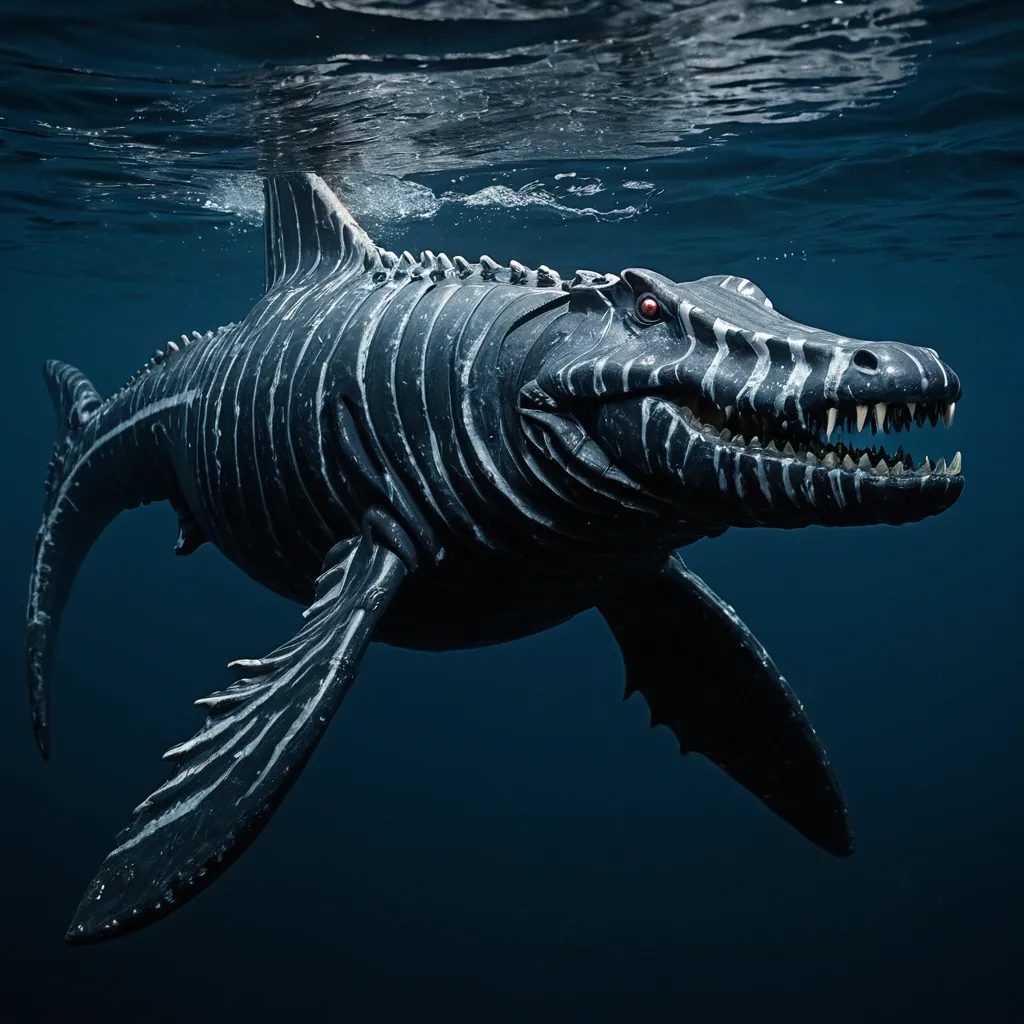
Length: 40-60 feet Weight: 50-75 tons Lifespan: 100-135 years Coloration: Males: Jet black base with light gray tiger stripes Females: Slate gray base with white tiger stripes Bioluminescent red photophores arranged in tiger stripe patterns along the flanks and dorsal ridge , glowing vividly in abyssal darkness Body: Robust , muscular frame combining the thick , armored scales of saltwater crocodile with the hydrodynamic , flexible body of Mosasaurus Hoffmannii Fins: Large , rigid pectoral fins capable of tilting backward to reduce drag , inspired by the Black Marlin’s speed adaptations Limbs: Powerful flippers adapted for both swimming and short-distance land movement , similar to a leopard seal’s scooting style Jaw: Enormous , reinforced jaws with over 40 , 000+ PSI bite force , lined with long , razor-sharp canine teeth from Predator X and Megalodon genetics Skin: Coated with a thick mucus layer secreted like the Atlantic hagfish , providing parasite defense , moisture retention , and a slippery surface to evade predators and prey alike Respiratory system: Dual-function lungs and gills allow breathing in surface air and extracting oxygen from water , enabling survival from ocean surface to depths up to 9 , 800 feet Sensory: Passive listening capabilities from transient killer whale lineage enable near-silent hunting; bioluminescent photophores aid in communication and prey attraction in deep-sea darkness ,
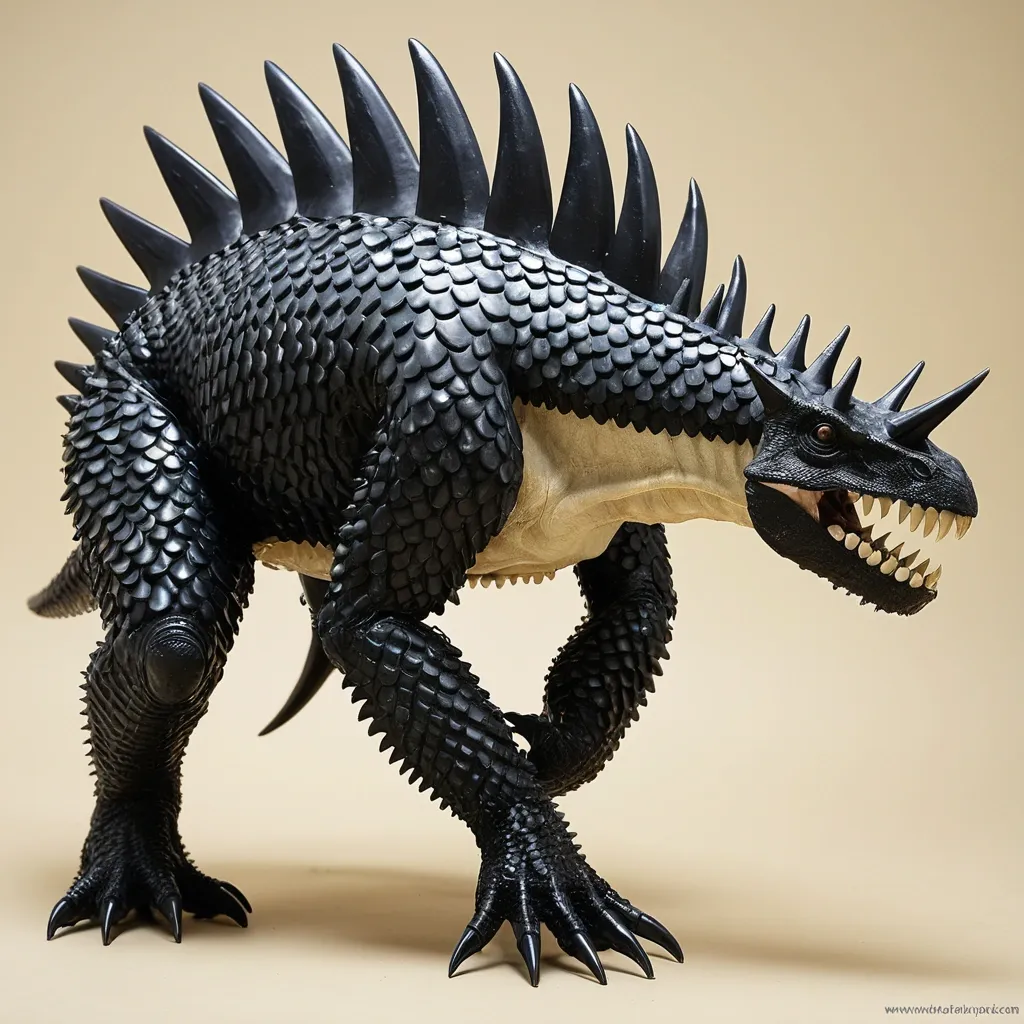
Physical Characteristics: Venenosus Regina is a titanic hybrid dinosaur standing approximately 20 feet tall at the shoulders and stretching 40 feet in length. Its frame is a powerful fusion of Tyrannosaurus rex and Giganotosaurus bulk , with a head shape that blends the robust cranial features of Giganotosaurus and the bony crown of Triceratops. The jawline is adorned with formidable bony spikes on each side , reminiscent of Triceratops horns , enhancing both offense and defense. Its body is armored with large , jet-black , glossy keratin scales inherited from Giant Pangolin DNA , interspersed with cream-colored underbelly patches. These scales are embedded with chromatophore cells from cuttlefish DNA , allowing Venenosus Regina to rapidly alter its skin color , texture , and pattern for camouflage or intimidation. The overall silhouette is muscular , lean and agile , with reduced hind legs that enable knuckle-walking , a trait borrowed from chimpanzee DNA , granting it a unique locomotion style that balances speed and stability.The forelimbs are robust and highly dexterous , equipped with slashing hook claws inspired by Saurophaganax and chimpanzee genetics , capable of delivering devastating swipes and manipulating tools or prey with precision. ,
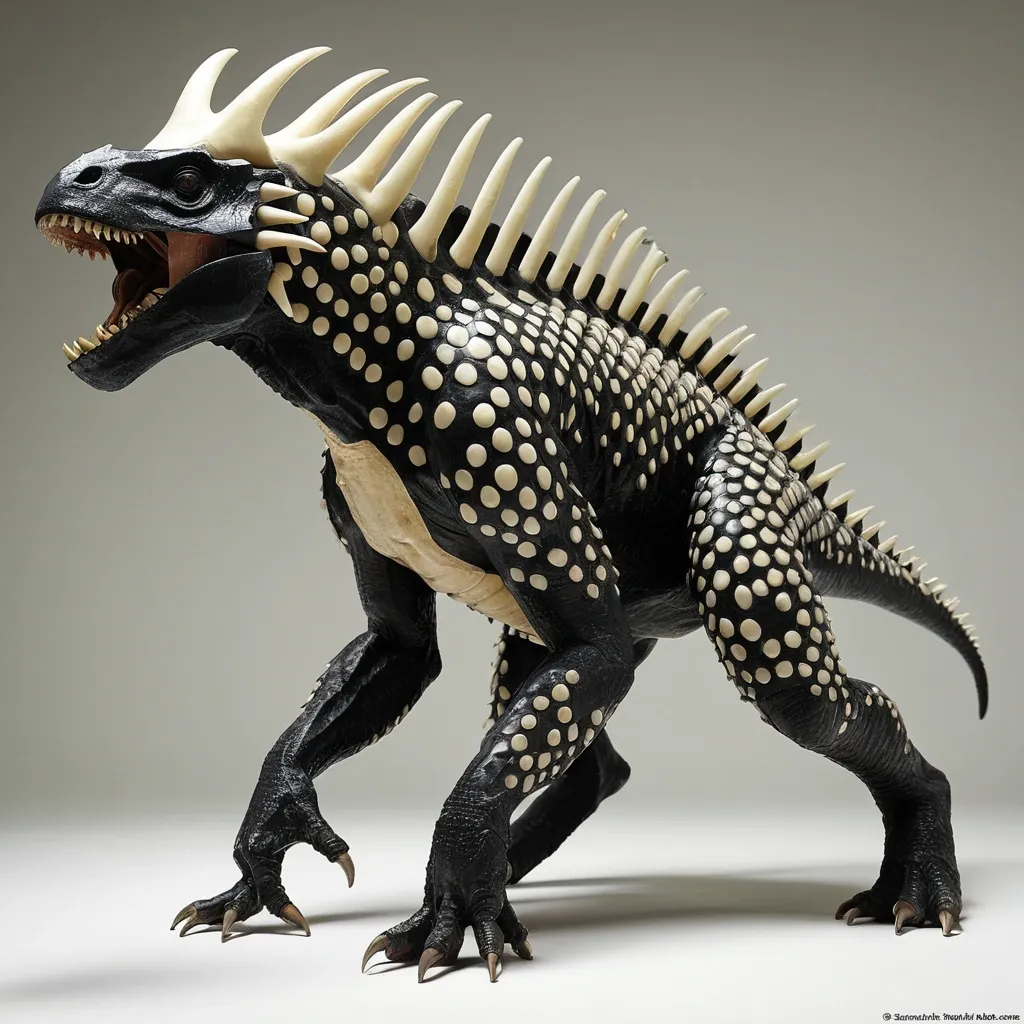
Physical Characteristics: Venenosus Regina is a titanic hybrid dinosaur standing approximately 20 feet tall at the shoulders and stretching 40 feet in length. Its frame is a powerful fusion of Tyrannosaurus rex and Giganotosaurus bulk , with a head shape that blends the robust cranial features of Giganotosaurus and the bony crown of Triceratops. The jawline is adorned with formidable bony spikes on each side , reminiscent of Triceratops horns , enhancing both offense and defense. Its body is armored with large , jet-black , glossy keratin scales inherited from Giant Pangolin DNA , interspersed with cream-colored underbelly patches. These scales are embedded with chromatophore cells from cuttlefish DNA , allowing Venenosus Regina to rapidly alter its skin color , texture , and pattern for camouflage or intimidation. The overall silhouette is muscular , lean and agile , with reduced hind legs that enable knuckle-walking , a trait borrowed from chimpanzee DNA , granting it a unique locomotion style that balances speed and stability.The forelimbs are robust and highly dexterous , equipped with slashing hook claws inspired by Saurophaganax and chimpanzee genetics , capable of delivering devastating swipes and manipulating tools or prey with precision. ,
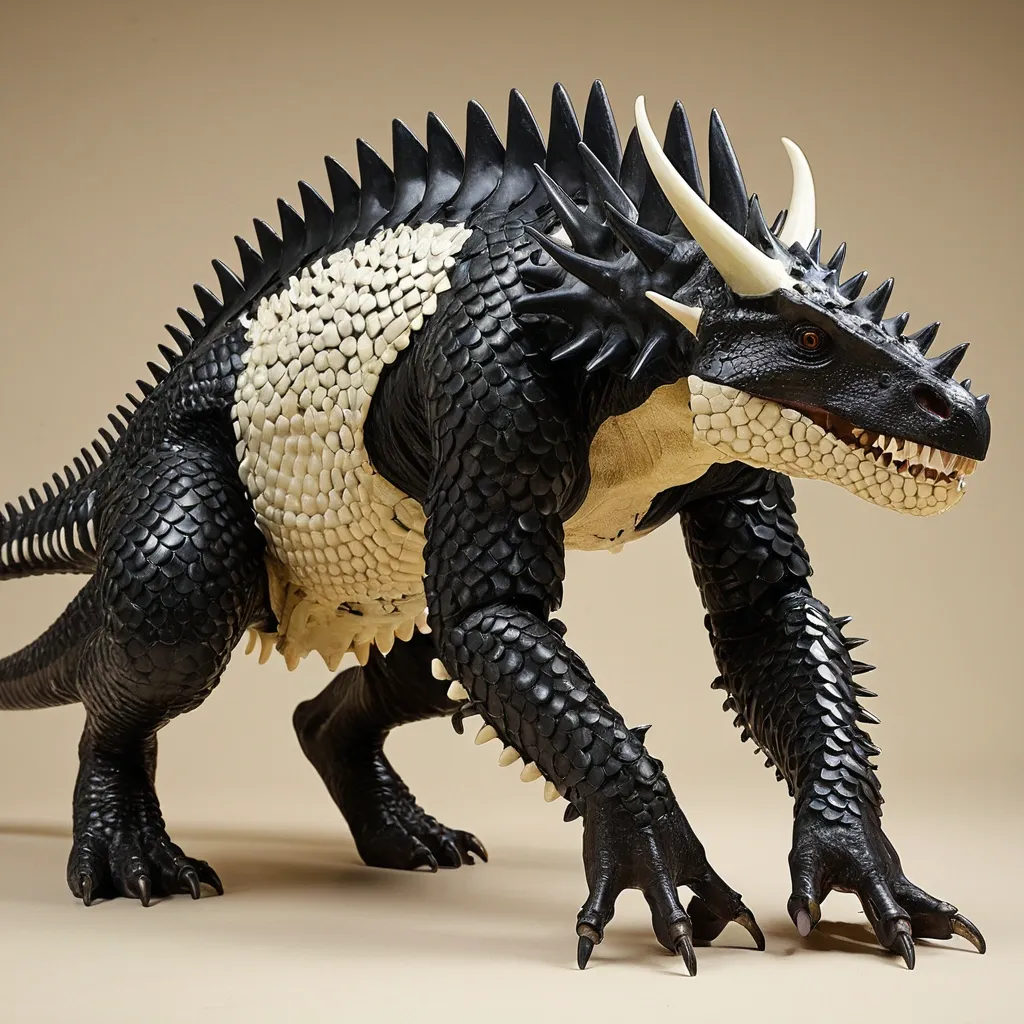
Physical Characteristics: Venenosus Regina is a titanic hybrid dinosaur standing approximately 20 feet tall at the shoulders and stretching 40 feet in length. Its frame is a powerful fusion of Tyrannosaurus rex and Giganotosaurus bulk , with a head shape that blends the robust cranial features of Giganotosaurus and the bony crown of Triceratops. The jawline is adorned with formidable bony spikes on each side , reminiscent of Triceratops horns , enhancing both offense and defense. Its body is armored with large , jet-black , glossy keratin scales inherited from Giant Pangolin DNA , interspersed with cream-colored underbelly patches. These scales are embedded with chromatophore cells from cuttlefish DNA , allowing Venenosus Regina to rapidly alter its skin color , texture , and pattern for camouflage or intimidation. The overall silhouette is muscular , lean and agile , with reduced hind legs that enable knuckle-walking , a trait borrowed from chimpanzee DNA , granting it a unique locomotion style that balances speed and stability.The forelimbs are robust and highly dexterous , equipped with slashing hook claws inspired by Saurophaganax and chimpanzee genetics , capable of delivering devastating swipes and manipulating tools or prey with precision. ,
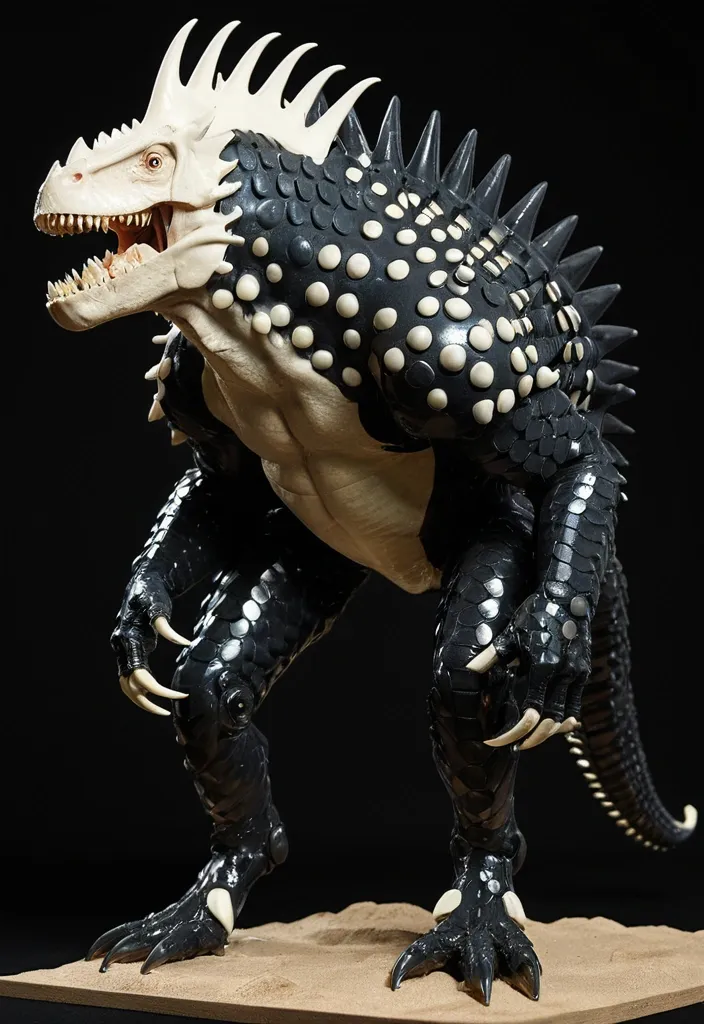
Physical Characteristics: Venenosus Regina is a titanic hybrid dinosaur standing approximately 20 feet tall at the shoulders and stretching 40 feet in length. Its frame is a powerful fusion of Tyrannosaurus rex and Giganotosaurus bulk , with a head shape that blends the robust cranial features of Giganotosaurus and the bony crown of Triceratops. The jawline is adorned with formidable bony spikes on each side , reminiscent of Triceratops horns , enhancing both offense and defense. Its body is armored with large , jet-black , glossy keratin scales inherited from Giant Pangolin DNA , interspersed with cream-colored underbelly patches. These scales are embedded with chromatophore cells from cuttlefish DNA , allowing Venenosus Regina to rapidly alter its skin color , texture , and pattern for camouflage or intimidation. The overall silhouette is muscular , lean and agile , with reduced hind legs that enable knuckle-walking , a trait borrowed from chimpanzee DNA , granting it a unique locomotion style that balances speed and stability.The forelimbs are robust and highly dexterous , equipped with slashing hook claws inspired by Saurophaganax and chimpanzee genetics , capable of delivering devastating swipes and manipulating tools or prey with precision. ,
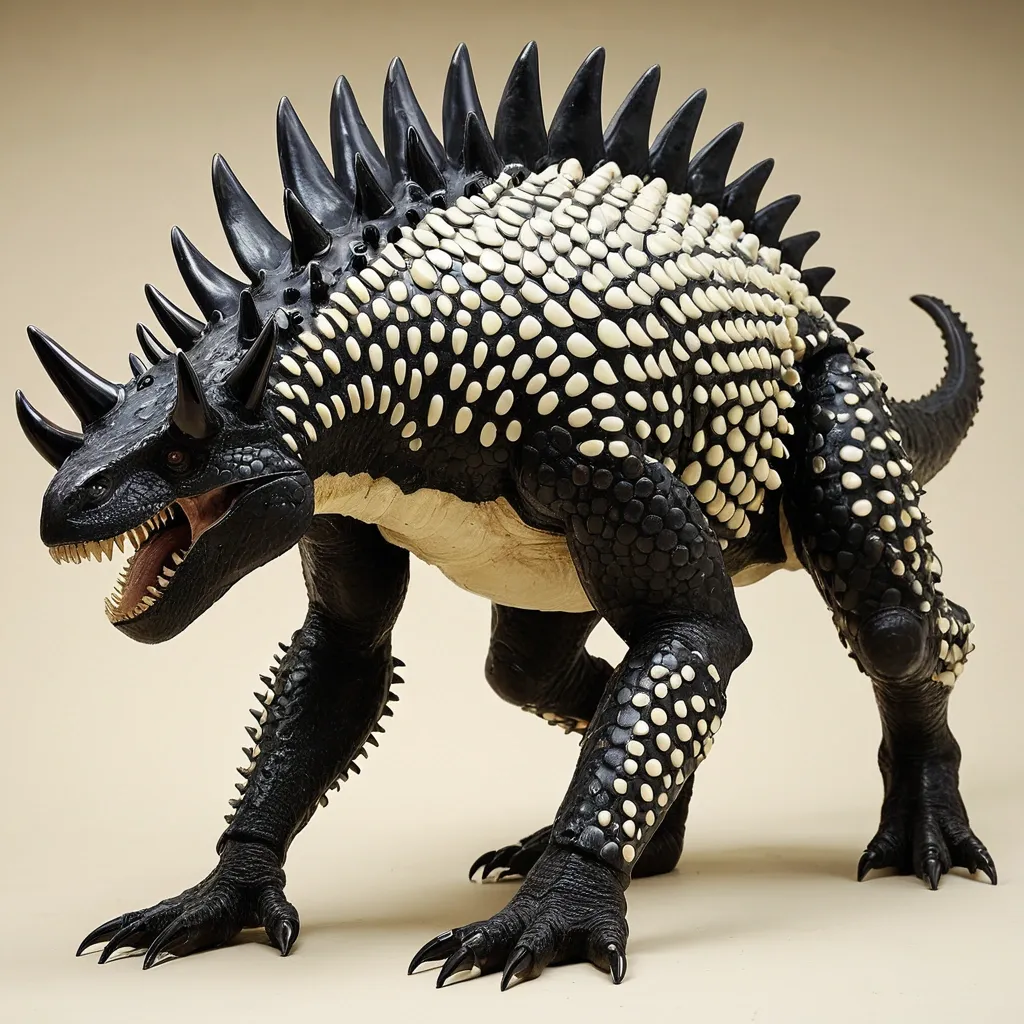
Physical Characteristics: Venenosus Regina is a titanic hybrid dinosaur standing approximately 20 feet tall at the shoulders and stretching 40 feet in length. Its frame is a powerful fusion of Tyrannosaurus rex and Giganotosaurus bulk , with a head shape that blends the robust cranial features of Giganotosaurus and the bony crown of Triceratops. The jawline is adorned with formidable bony spikes on each side , reminiscent of Triceratops horns , enhancing both offense and defense. Its body is armored with large , jet-black , glossy keratin scales inherited from Giant Pangolin DNA , interspersed with cream-colored underbelly patches. These scales are embedded with chromatophore cells from cuttlefish DNA , allowing Venenosus Regina to rapidly alter its skin color , texture , and pattern for camouflage or intimidation. The overall silhouette is muscular , lean and agile , with reduced hind legs that enable knuckle-walking , a trait borrowed from chimpanzee DNA , granting it a unique locomotion style that balances speed and stability.The forelimbs are robust and highly dexterous , equipped with slashing hook claws inspired by Saurophaganax and chimpanzee genetics , capable of delivering devastating swipes and manipulating tools or prey with precision. ,
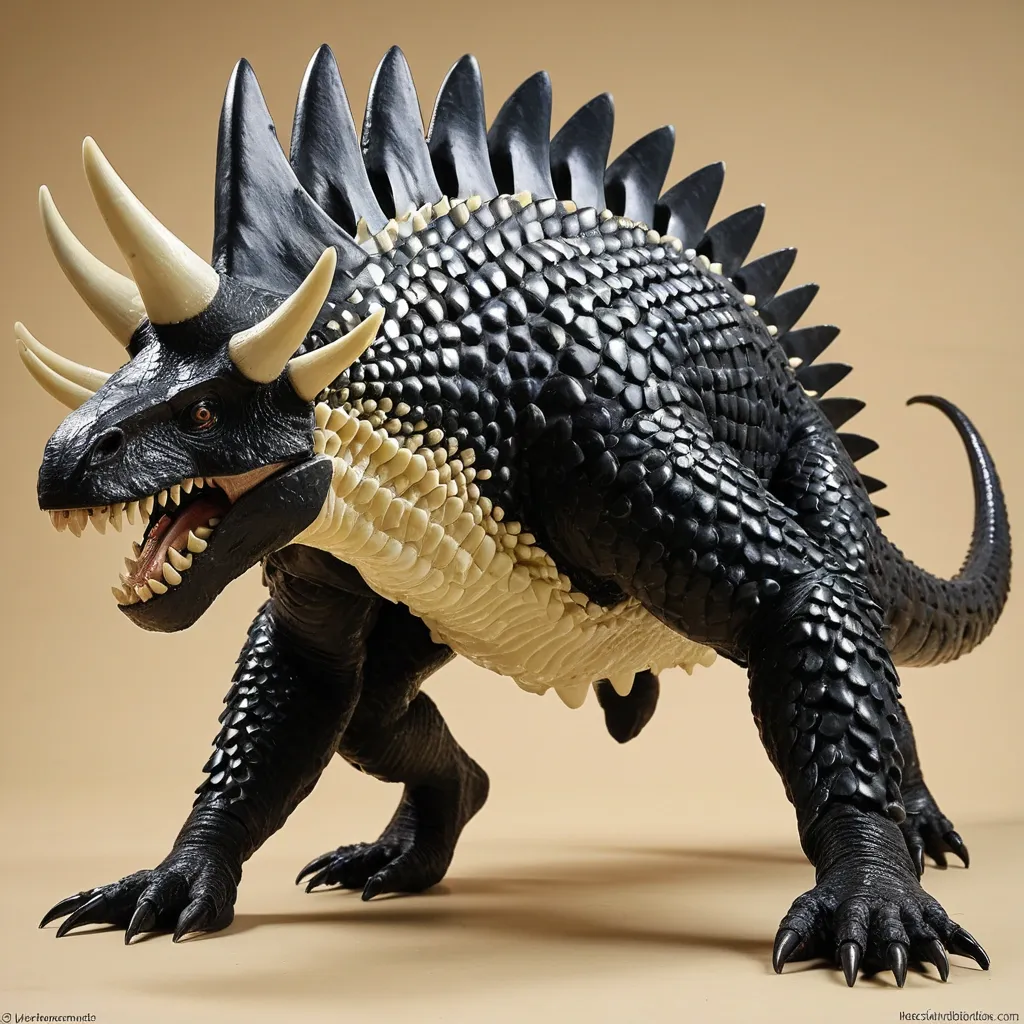
Physical Characteristics: Venenosus Regina is a titanic hybrid dinosaur standing approximately 20 feet tall at the shoulders and stretching 40 feet in length. Its frame is a powerful fusion of Tyrannosaurus rex and Giganotosaurus bulk , with a head shape that blends the robust cranial features of Giganotosaurus and the bony crown of Triceratops. The jawline is adorned with formidable bony spikes on each side , reminiscent of Triceratops horns , enhancing both offense and defense. Its body is armored with large , jet-black , glossy keratin scales inherited from Giant Pangolin DNA , interspersed with cream-colored underbelly patches. These scales are embedded with chromatophore cells from cuttlefish DNA , allowing Venenosus Regina to rapidly alter its skin color , texture , and pattern for camouflage or intimidation. The overall silhouette is muscular , lean and agile , with reduced hind legs that enable knuckle-walking , a trait borrowed from chimpanzee DNA , granting it a unique locomotion style that balances speed and stability.The forelimbs are robust and highly dexterous , equipped with slashing hook claws inspired by Saurophaganax and chimpanzee genetics , capable of delivering devastating swipes and manipulating tools or prey with precision. ,
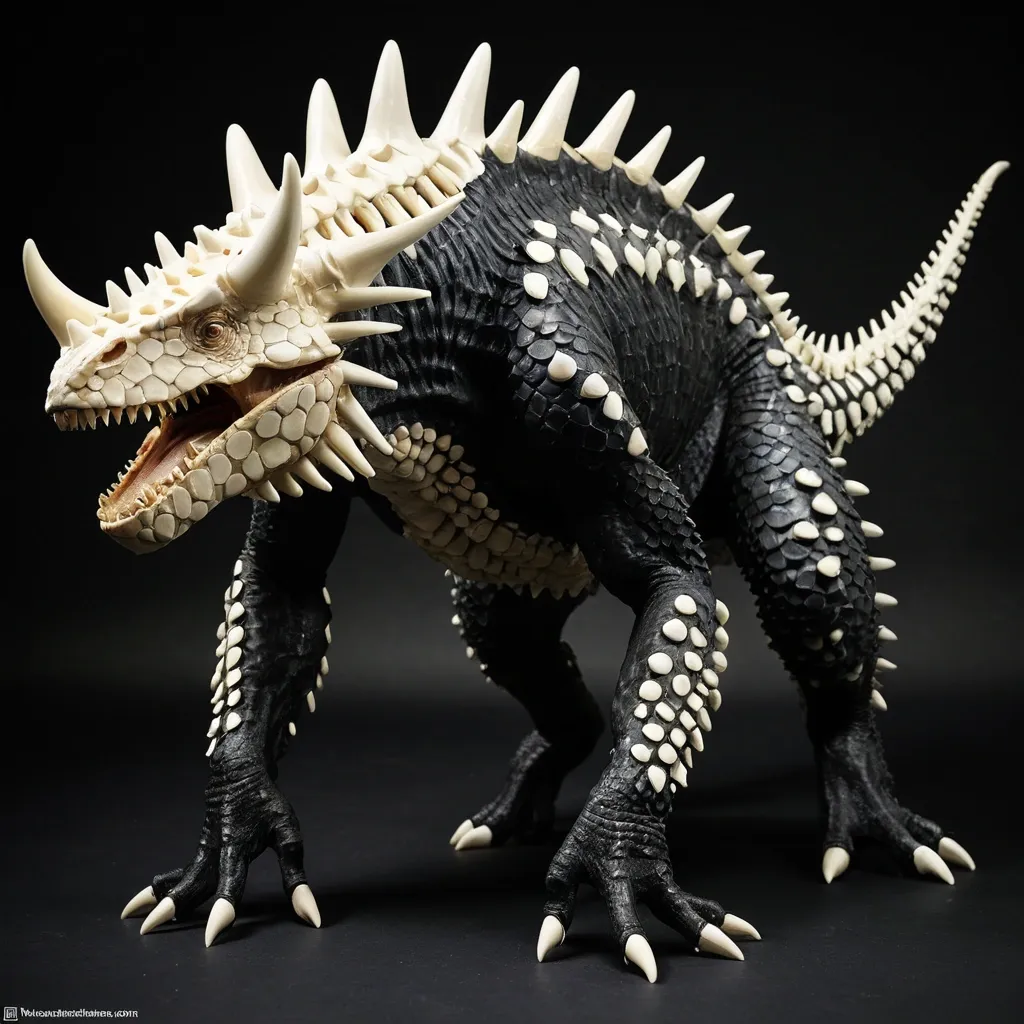
Physical Characteristics: Venenosus Regina is a titanic hybrid dinosaur standing approximately 20 feet tall at the shoulders and stretching 40 feet in length. Its frame is a powerful fusion of Tyrannosaurus rex and Giganotosaurus bulk , with a head shape that blends the robust cranial features of Giganotosaurus and the bony crown of Triceratops. The jawline is adorned with formidable bony spikes on each side , reminiscent of Triceratops horns , enhancing both offense and defense. Its body is armored with large , jet-black , glossy keratin scales inherited from Giant Pangolin DNA , interspersed with cream-colored underbelly patches. These scales are embedded with chromatophore cells from cuttlefish DNA , allowing Venenosus Regina to rapidly alter its skin color , texture , and pattern for camouflage or intimidation. The overall silhouette is muscular , lean and agile , with reduced hind legs that enable knuckle-walking , a trait borrowed from chimpanzee DNA , granting it a unique locomotion style that balances speed and stability.The forelimbs are robust and highly dexterous , equipped with slashing hook claws inspired by Saurophaganax and chimpanzee genetics , capable of delivering devastating swipes and manipulating tools or prey with precision. ,
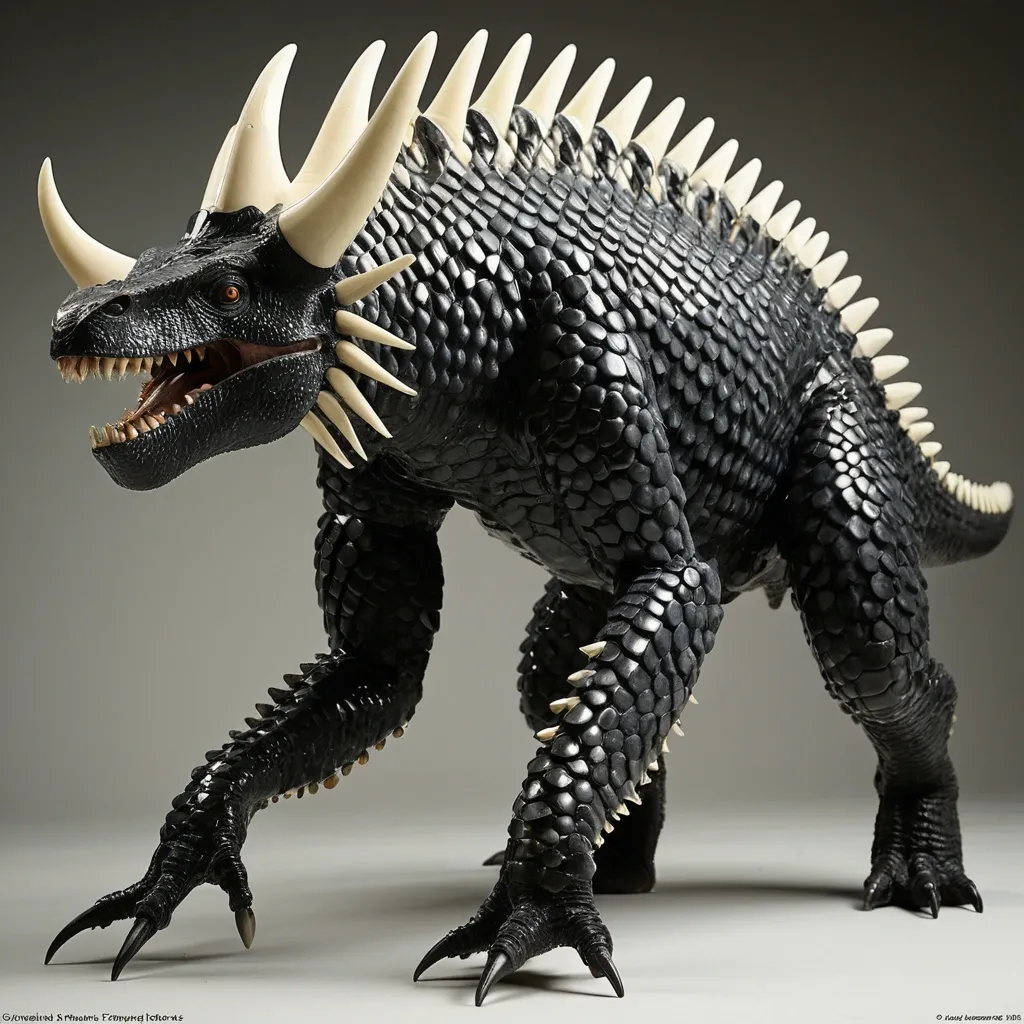
Physical Characteristics: Venenosus Regina is a titanic hybrid dinosaur standing approximately 20 feet tall at the shoulders and stretching 40 feet in length. Its frame is a powerful fusion of Tyrannosaurus rex and Giganotosaurus bulk , with a head shape that blends the robust cranial features of Giganotosaurus and the bony crown of Triceratops. The jawline is adorned with formidable bony spikes on each side , reminiscent of Triceratops horns , enhancing both offense and defense. Its body is armored with large , jet-black , glossy keratin scales inherited from Giant Pangolin DNA , interspersed with cream-colored underbelly patches. These scales are embedded with chromatophore cells from cuttlefish DNA , allowing Venenosus Regina to rapidly alter its skin color , texture , and pattern for camouflage or intimidation. The overall silhouette is muscular , lean and agile , with reduced hind legs that enable knuckle-walking , a trait borrowed from chimpanzee DNA , granting it a unique locomotion style that balances speed and stability.The forelimbs are robust and highly dexterous , equipped with slashing hook claws inspired by Saurophaganax and chimpanzee genetics , capable of delivering devastating swipes and manipulating tools or prey with precision. ,
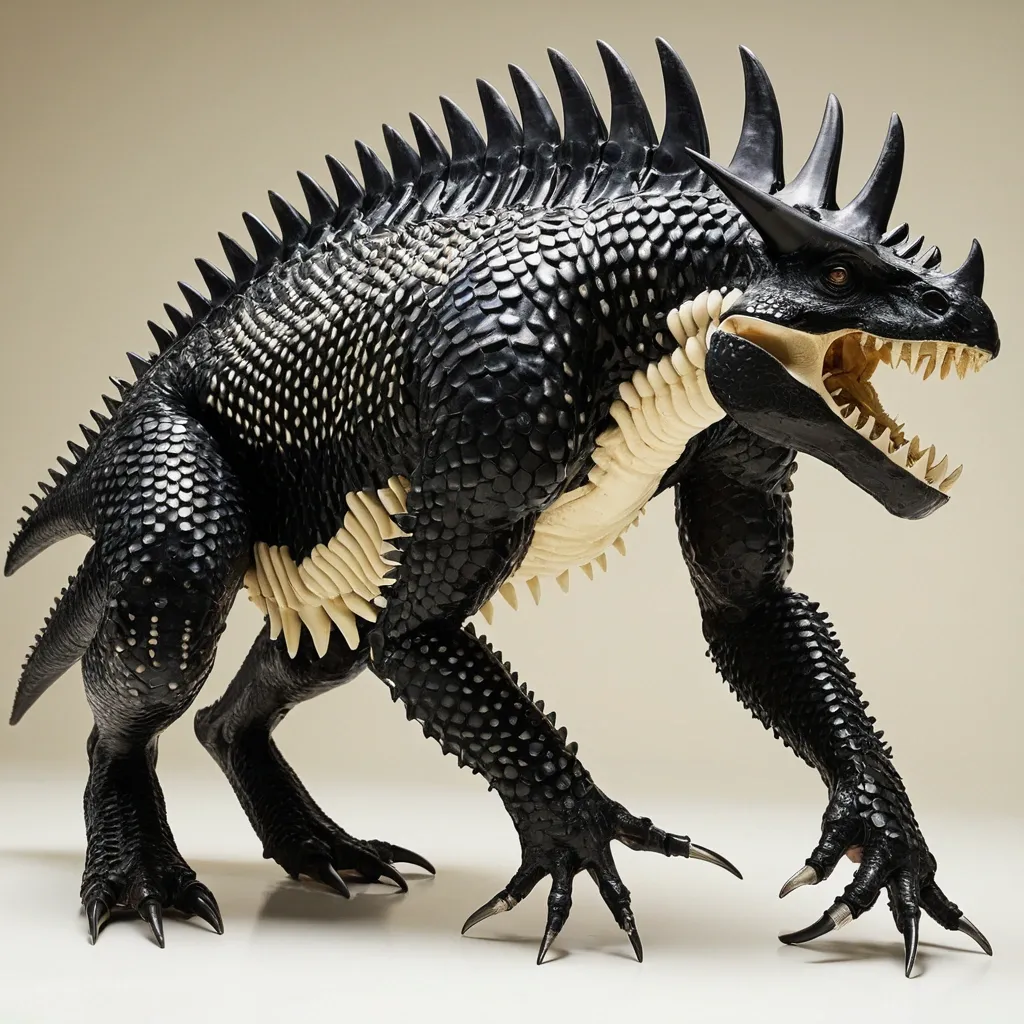
Physical Characteristics: Venenosus Regina is a titanic hybrid dinosaur standing approximately 20 feet tall at the shoulders and stretching 40 feet in length. Its frame is a powerful fusion of Tyrannosaurus rex and Giganotosaurus bulk , with a head shape that blends the robust cranial features of Giganotosaurus and the bony crown of Triceratops. The jawline is adorned with formidable bony spikes on each side , reminiscent of Triceratops horns , enhancing both offense and defense. Its body is armored with large , jet-black , glossy keratin scales inherited from Giant Pangolin DNA , interspersed with cream-colored underbelly patches. These scales are embedded with chromatophore cells from cuttlefish DNA , allowing Venenosus Regina to rapidly alter its skin color , texture , and pattern for camouflage or intimidation. The overall silhouette is muscular , lean and agile , with reduced hind legs that enable knuckle-walking , a trait borrowed from chimpanzee DNA , granting it a unique locomotion style that balances speed and stability.The forelimbs are robust and highly dexterous , equipped with slashing hook claws inspired by Saurophaganax and chimpanzee genetics , capable of delivering devastating swipes and manipulating tools or prey with precision. ,
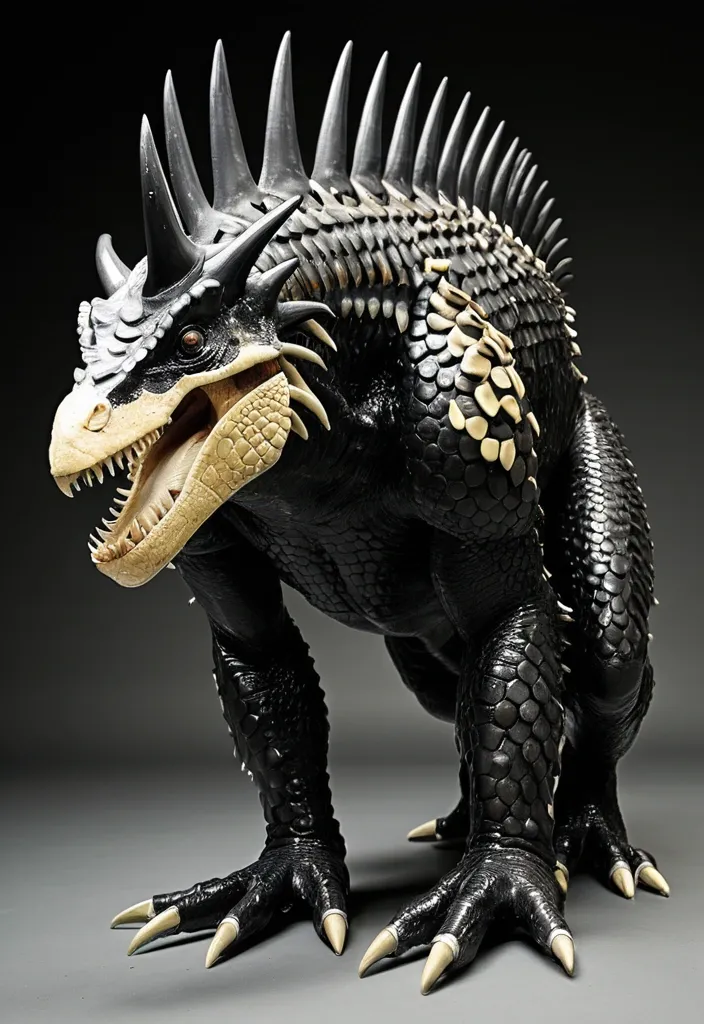
Physical Characteristics: Venenosus Regina is a titanic hybrid dinosaur standing approximately 20 feet tall at the shoulders and stretching 40 feet in length. Its frame is a powerful fusion of Tyrannosaurus rex and Giganotosaurus bulk , with a head shape that blends the robust cranial features of Giganotosaurus and the bony crown of Triceratops. The jawline is adorned with formidable bony spikes on each side , reminiscent of Triceratops horns , enhancing both offense and defense. Its body is armored with large , jet-black , glossy keratin scales inherited from Giant Pangolin DNA , interspersed with cream-colored underbelly patches. These scales are embedded with chromatophore cells from cuttlefish DNA , allowing Venenosus Regina to rapidly alter its skin color , texture , and pattern for camouflage or intimidation. The overall silhouette is muscular , lean and agile , with reduced hind legs that enable knuckle-walking , a trait borrowed from chimpanzee DNA , granting it a unique locomotion style that balances speed and stability.The forelimbs are robust and highly dexterous , equipped with slashing hook claws inspired by Saurophaganax and chimpanzee genetics , capable of delivering devastating swipes and manipulating tools or prey with precision. ,

Physical Characteristics: Venenosus Regina is a titanic hybrid dinosaur standing approximately 20 feet tall at the shoulders and stretching 40 feet in length. Its frame is a powerful fusion of Tyrannosaurus rex and Giganotosaurus bulk , with a head shape that blends the robust cranial features of Giganotosaurus and the bony crown of Triceratops. The jawline is adorned with formidable bony spikes on each side , reminiscent of Triceratops horns , enhancing both offense and defense. Its body is armored with large , jet-black , glossy keratin scales inherited from Giant Pangolin DNA , interspersed with cream-colored underbelly patches. These scales are embedded with chromatophore cells from cuttlefish DNA , allowing Venenosus Regina to rapidly alter its skin color , texture , and pattern for camouflage or intimidation. The overall silhouette is muscular , lean and agile , with reduced hind legs that enable knuckle-walking , a trait borrowed from chimpanzee DNA , granting it a unique locomotion style that balances speed and stability.The forelimbs are robust and highly dexterous , equipped with slashing hook claws inspired by Saurophaganax and chimpanzee genetics , capable of delivering devastating swipes and manipulating tools or prey with precision. ,
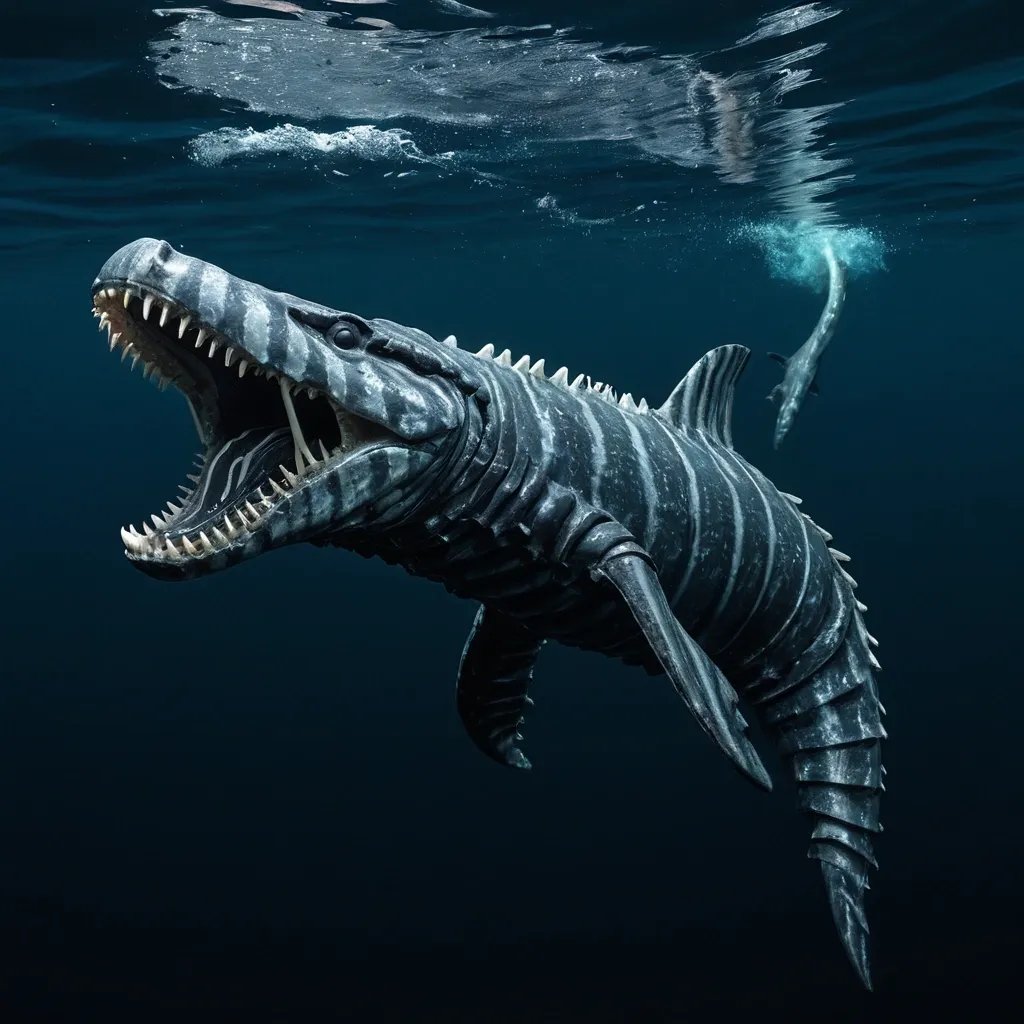
Length: 40-60 feet Weight: 50-75 tons Lifespan: 100-135 years Coloration of the Females is Slate gray base with white tiger stripes Bioluminescent red photophores arranged in tiger stripe patterns along the flanks and dorsal ridge , glowing vividly in abyssal darkness Body: Robust , muscular frame combining the thick , armored scales of saltwater crocodile with the hydrodynamic , flexible body of Mosasaurus Hoffmannii Fins: Large , rigid pectoral fins capable of tilting backward to reduce drag , inspired by the Black Marlin’s speed adaptations Limbs: Powerful flippers adapted for both swimming and short-distance land movement , similar to a leopard seal’s scooting style Jaw: Enormous , reinforced jaws with over 40 , 000+ PSI bite force , lined with long , razor-sharp canine teeth from Predator X and Megalodon genetics Skin: Coated with a thick mucus layer secreted like the Atlantic hagfish , providing parasite defense , moisture retention , and a slippery surface to evade predators and prey alike Respiratory system: Dual-function lungs and gills allow breathing in surface air and extracting oxygen from water , enabling survival from ocean surface to depths up to 9 , 800 feet Sensory: Passive listening capabilities from transient killer whale lineage enable near-silent hunting; bioluminescent photophores aid in communication and prey attraction in deep-sea darkness ,

Length: 40-60 feet Weight: 50-75 tons Lifespan: 100-135 years Coloration: Males: Jet black base with light gray tiger stripes Females: Slate gray base with white tiger stripes Bioluminescent red photophores arranged in tiger stripe patterns along the flanks and dorsal ridge , glowing vividly in abyssal darkness Body: Robust , muscular frame combining the thick , armored scales of saltwater crocodile with the hydrodynamic , flexible body of Mosasaurus Hoffmannii Fins: Large , rigid pectoral fins capable of tilting backward to reduce drag , inspired by the Black Marlin’s speed adaptations Limbs: Powerful flippers adapted for both swimming and short-distance land movement , similar to a leopard seal’s scooting style Jaw: Enormous , reinforced jaws with over 40 , 000+ PSI bite force , lined with long , razor-sharp canine teeth from Predator X and Megalodon genetics Skin: Coated with a thick mucus layer secreted like the Atlantic hagfish , providing parasite defense , moisture retention , and a slippery surface to evade predators and prey alike Respiratory system: Dual-function lungs and gills allow breathing in surface air and extracting oxygen from water , enabling survival from ocean surface to depths up to 9 , 800 feet Sensory: Passive listening capabilities from transient killer whale lineage enable near-silent hunting; bioluminescent photophores aid in communication and prey attraction in deep-sea darkness ,
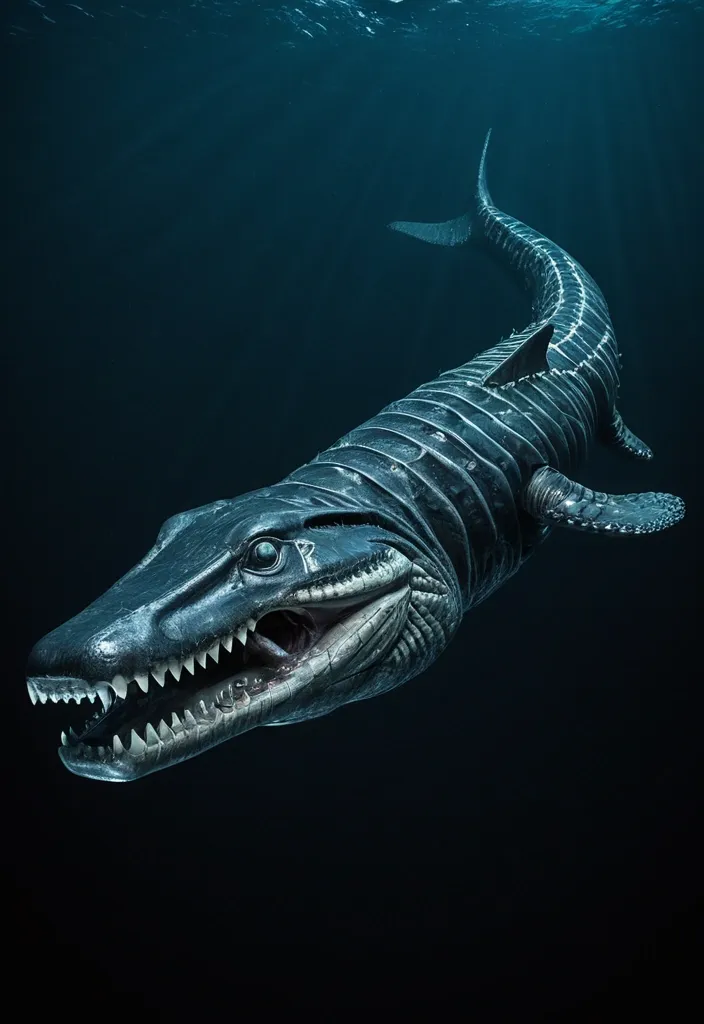
Physical Characteristics:Length: 40-60 feetWeight: 50-75 tonsLifespan: 100-135 years Coloration: Females are a slate gray base with white tiger stripes. Bioluminescent red photophores arranged in tiger stripe patterns along the flanks and dorsal ridge , glowing vividly in abyssal darkness Body: Robust , muscular frame combining the thick , armored scales of saltwater crocodile with the hydrodynamic , flexible body of Mosasaurus Hoffmannii. Fins: Large , rigid pectoral fins capable of tilting backward to reduce drag , inspired by the Black Marlin’s speed adaptations. Limbs: Powerful flippers adapted for both swimming and short-distance land movement , similar to a leopard seal’s scooting style. Jaw: Enormous , reinforced jaws with over 40 , 000 PSI bite force , lined with long , razor-sharp canine teeth from Predator X and Megalodon genetics. Skin: Coated with a thick mucus layer secreted like the Atlantic hagfish , providing parasite defense , moisture retention , and a slippery surface to evade predators and prey alike. Respiratory system: Dual-function lungs and gills allow breathing in surface air and extracting oxygen from water , enabling survival from ocean surface to depths up to 9 , 800 feet. Sensory: Passive listening capabilities from transient killer whale lineage enable near-silent hunting; bioluminescent photophores aid in communication and prey attraction in deep-sea darkness ,
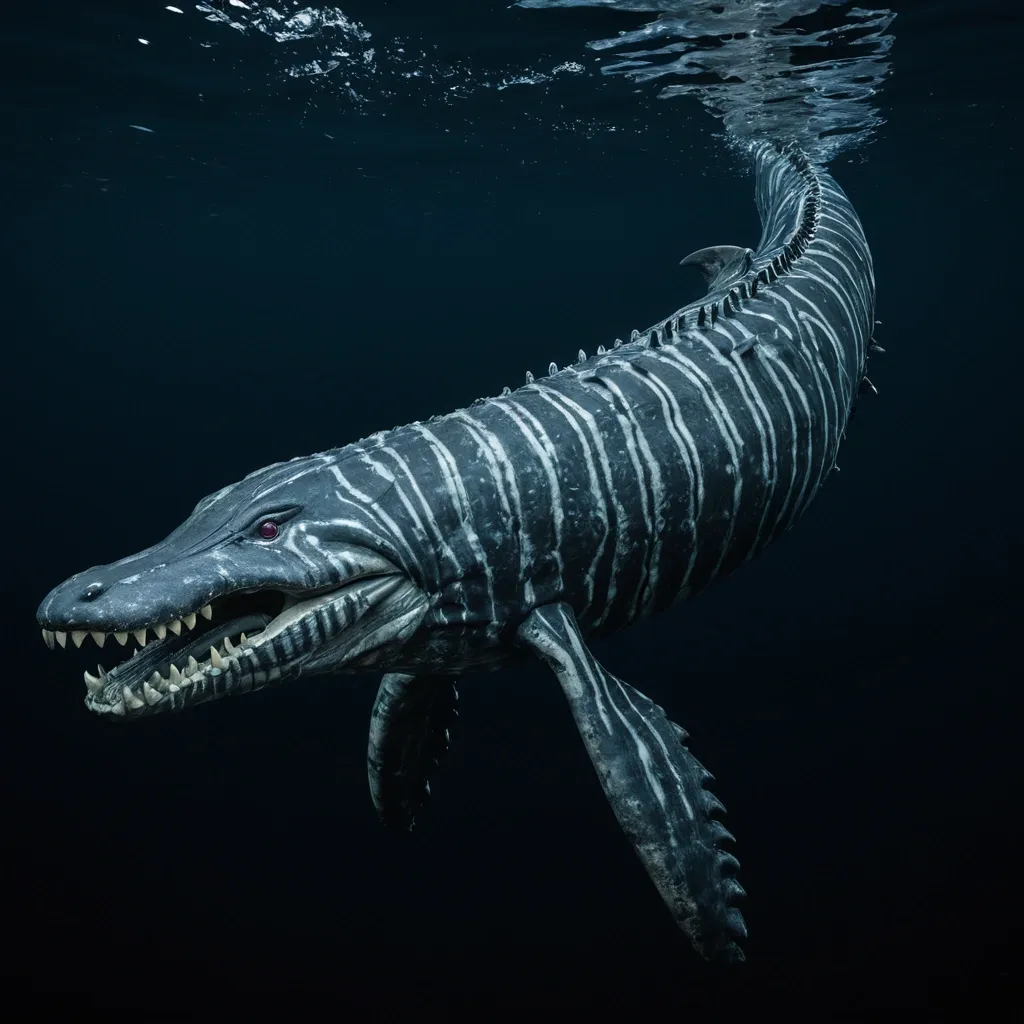
Physical Characteristics:Length: 40-60 feetWeight: 50-75 tonsLifespan: 100-135 years Coloration: Females are a slate gray base with white tiger stripes. Bioluminescent red photophores arranged in tiger stripe patterns along the flanks and dorsal ridge , glowing vividly in abyssal darkness Body: Robust , muscular frame combining the thick , armored scales of saltwater crocodile with the hydrodynamic , flexible body of Mosasaurus Hoffmannii. Fins: Large , rigid pectoral fins capable of tilting backward to reduce drag , inspired by the Black Marlin’s speed adaptations. Limbs: Powerful flippers adapted for both swimming and short-distance land movement , similar to a leopard seal’s scooting style. Jaw: Enormous , reinforced jaws with over 40 , 000 PSI bite force , lined with long , razor-sharp canine teeth from Predator X and Megalodon genetics. Skin: Coated with a thick mucus layer secreted like the Atlantic hagfish , providing parasite defense , moisture retention , and a slippery surface to evade predators and prey alike. Respiratory system: Dual-function lungs and gills allow breathing in surface air and extracting oxygen from water , enabling survival from ocean surface to depths up to 9 , 800 feet. Sensory: Passive listening capabilities from transient killer whale lineage enable near-silent hunting; bioluminescent photophores aid in communication and prey attraction in deep-sea darkness ,
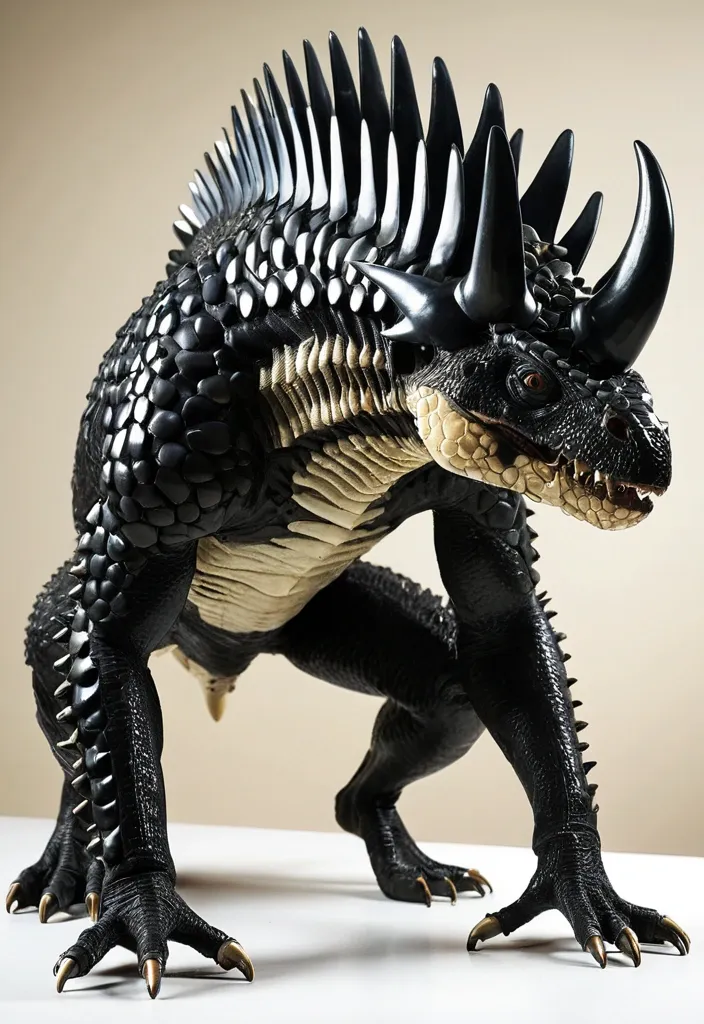
Physical Characteristics: Venenosus Regina is a titanic hybrid dinosaur standing approximately 20 feet tall at the shoulders and stretching 40 feet in length. Its frame is a powerful fusion of Tyrannosaurus rex and Giganotosaurus bulk , with a head shape that blends the robust cranial features of Giganotosaurus and the bony crown of Triceratops. The jawline is adorned with formidable bony spikes on each side , reminiscent of Triceratops horns , enhancing both offense and defense. Its body is armored with large , jet-black , glossy keratin scales inherited from Giant Pangolin DNA , interspersed with cream-colored underbelly patches. These scales are embedded with chromatophore cells from cuttlefish DNA , allowing Venenosus Regina to rapidly alter its skin color , texture , and pattern for camouflage or intimidation. The overall silhouette is muscular , lean and agile , with reduced hind legs that enable knuckle-walking , a trait borrowed from chimpanzee DNA , granting it a unique locomotion style that balances speed and stability.The forelimbs are robust and highly dexterous , equipped with slashing hook claws inspired by Saurophaganax and chimpanzee genetics , capable of delivering devastating swipes and manipulating tools or prey with precision. ,
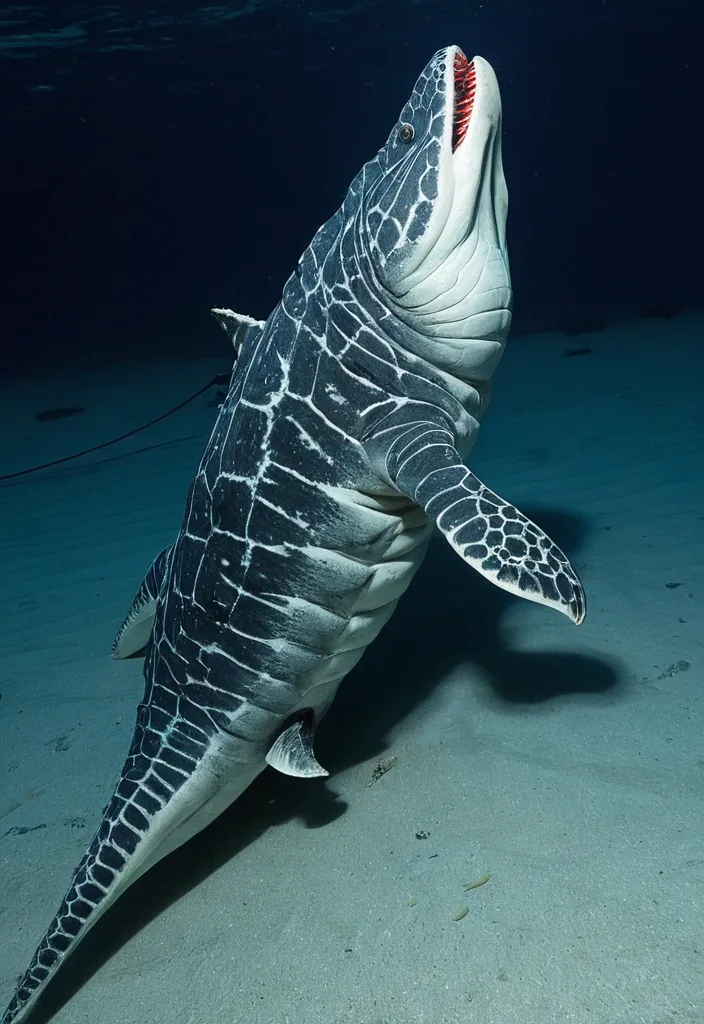
Physical Characteristics:Length: 40-60 feet Weight: 50-75 tons Lifespan: 100-135 years Coloration: Females are a slate gray base with white tiger stripes with Bioluminescent red photophores arranged in tiger stripe patterns along the flanks and dorsal ridge , glowing vividly in abyssal darkness Body: Robust , muscular frame combining the thick , armored scales of saltwater crocodile with the hydrodynamic , flexible body of Mosasaurus Hoffmannii. Fins: Large , rigid pectoral fins capable of tilting backward to reduce drag , inspired by the Black Marlin’s speed adaptations. Limbs: Powerful flippers adapted for both swimming and short-distance land movement , similar to a leopard seal’s scooting style. Jaw: Enormous , reinforced jaws with over 40 , 000 PSI bite force , lined with long , razor-sharp canine teeth from Predator X and Megalodon genetics. Skin: Coated with a thick mucus layer secreted like the Atlantic hagfish , providing parasite defense , moisture retention , and a slippery surface to evade predators and prey alike. Defense: Venomous spines inspired by the crown-of-thorns starfish line the dorsal ridge , delivering painful wounds to predators or rivals. Respiratory system: Dual-function lungs and gills allow breathing in surface air and extracting oxygen from water , enabling survival from ocean surface to depths up to 9 , 800 feet. Sensory: Passive listening capabilities from transient killer whale lineage enable near-silent hunting; bioluminescent photophores aid in communication and prey attraction in deep-sea darkness ,
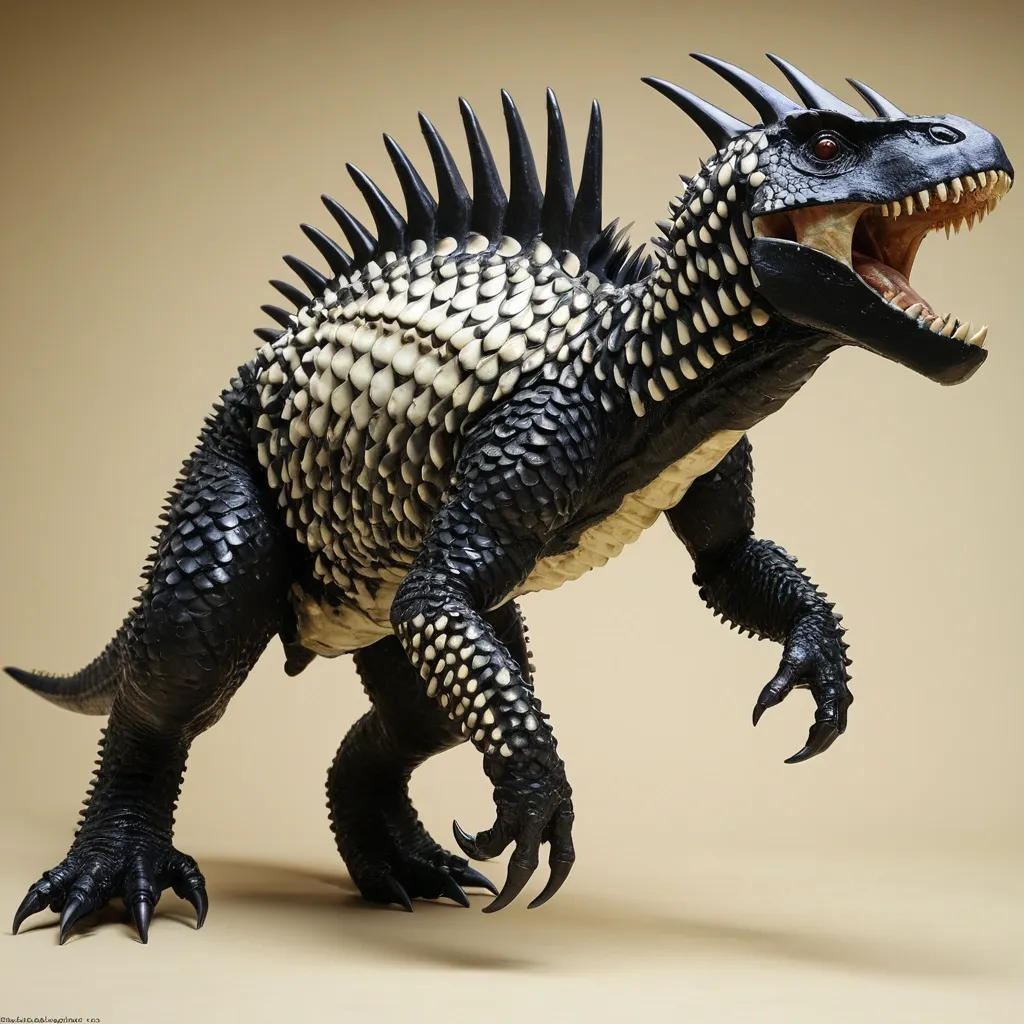
Physical Characteristics: Venenosus Regina is a titanic hybrid dinosaur standing approximately 20 feet tall at the shoulders and stretching 40 feet in length. Its frame is a powerful fusion of Tyrannosaurus rex and Giganotosaurus bulk , with a head shape that blends the robust cranial features of Giganotosaurus and the bony crown of Triceratops. The jawline is adorned with formidable bony spikes on each side , reminiscent of Triceratops horns , enhancing both offense and defense. Its body is armored with large , jet-black , glossy keratin scales inherited from Giant Pangolin DNA , interspersed with cream-colored underbelly patches. These scales are embedded with chromatophore cells from cuttlefish DNA , allowing Venenosus Regina to rapidly alter its skin color , texture , and pattern for camouflage or intimidation. The overall silhouette is muscular , lean and agile , with reduced hind legs that enable knuckle-walking , a trait borrowed from chimpanzee DNA , granting it a unique locomotion style that balances speed and stability.The forelimbs are robust and highly dexterous , equipped with slashing hook claws inspired by Saurophaganax and chimpanzee genetics , capable of delivering devastating swipes and manipulating tools or prey with precision. ,
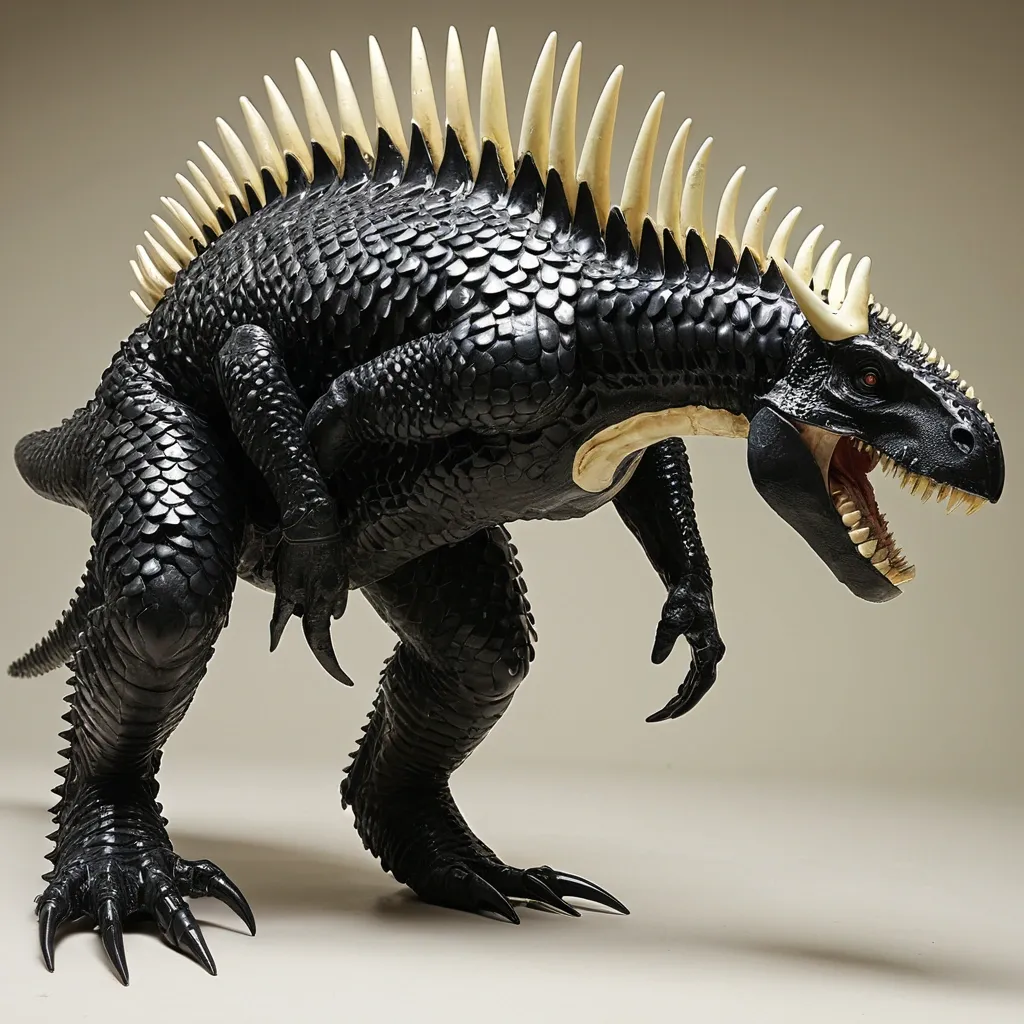
Physical Characteristics: Venenosus Regina is a titanic hybrid dinosaur standing approximately 20 feet tall at the shoulders and stretching 40 feet in length. Its frame is a powerful fusion of Tyrannosaurus rex and Giganotosaurus bulk , with a head shape that blends the robust cranial features of Giganotosaurus and the bony crown of Triceratops. The jawline is adorned with formidable bony spikes on each side , reminiscent of Triceratops horns , enhancing both offense and defense. Its body is armored with large , jet-black , glossy keratin scales inherited from Giant Pangolin DNA , interspersed with cream-colored underbelly patches. These scales are embedded with chromatophore cells from cuttlefish DNA , allowing Venenosus Regina to rapidly alter its skin color , texture , and pattern for camouflage or intimidation. The overall silhouette is muscular , lean and agile , with reduced hind legs that enable knuckle-walking , a trait borrowed from chimpanzee DNA , granting it a unique locomotion style that balances speed and stability.The forelimbs are robust and highly dexterous , equipped with slashing hook claws inspired by Saurophaganax and chimpanzee genetics , capable of delivering devastating swipes and manipulating tools or prey with precision. ,
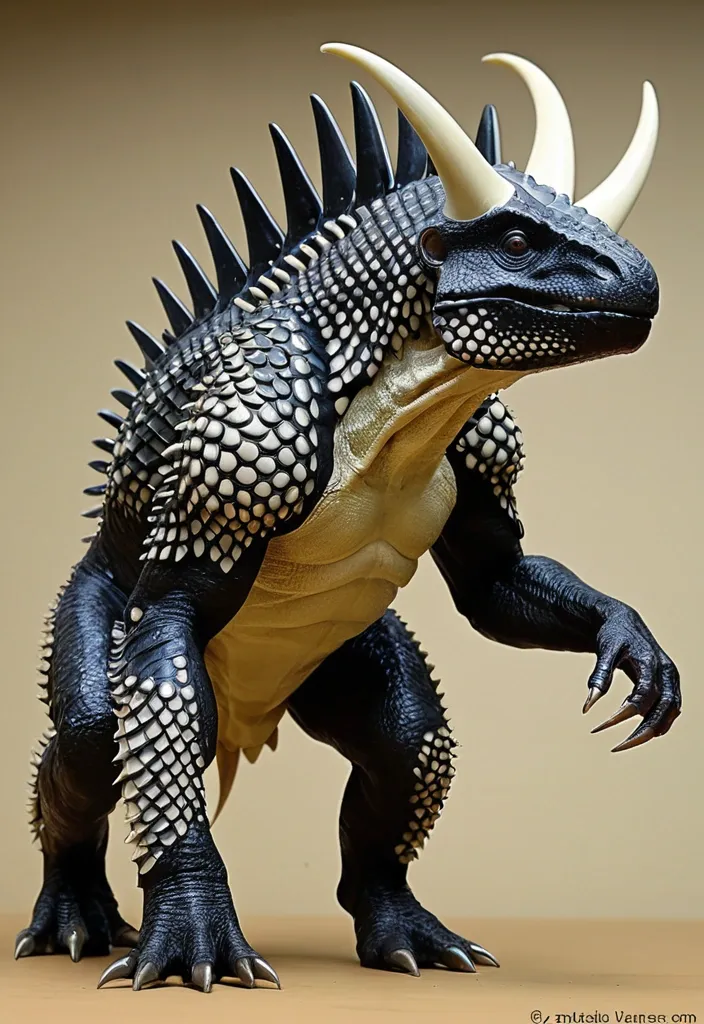
Physical Characteristics: Venenosus Regina is a titanic hybrid dinosaur standing approximately 20 feet tall at the shoulders and stretching 40 feet in length. Its frame is a powerful fusion of Tyrannosaurus rex and Giganotosaurus bulk , with a head shape that blends the robust cranial features of Giganotosaurus and the bony crown of Triceratops. The jawline is adorned with formidable bony spikes on each side , reminiscent of Triceratops horns , enhancing both offense and defense. Its body is armored with large , jet-black , glossy keratin scales inherited from Giant Pangolin DNA , interspersed with cream-colored underbelly patches. These scales are embedded with chromatophore cells from cuttlefish DNA , allowing Venenosus Regina to rapidly alter its skin color , texture , and pattern for camouflage or intimidation. The overall silhouette is muscular , lean and agile , with reduced hind legs that enable knuckle-walking , a trait borrowed from chimpanzee DNA , granting it a unique locomotion style that balances speed and stability.The forelimbs are robust and highly dexterous , equipped with slashing hook claws inspired by Saurophaganax and chimpanzee genetics , capable of delivering devastating swipes and manipulating tools or prey with precision. ,
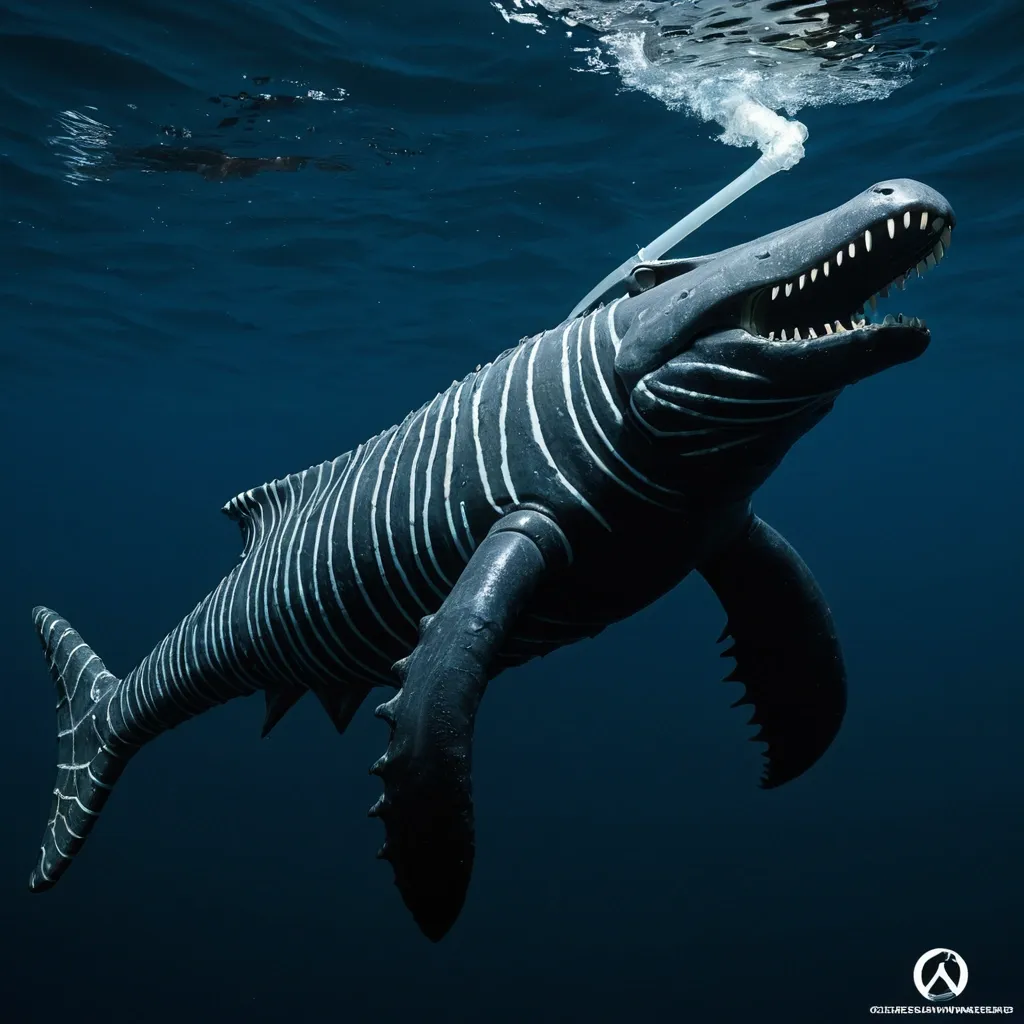
Length: 40-60 feet Weight: 50-75 tons Lifespan: 100-135 years Coloration of the Females is Slate gray base with white tiger stripes Bioluminescent red photophores arranged in tiger stripe patterns along the flanks and dorsal ridge , glowing vividly in abyssal darkness Body: Robust , muscular frame combining the thick , armored scales of saltwater crocodile with the hydrodynamic , flexible body of Mosasaurus Hoffmannii Fins: Large , rigid pectoral fins capable of tilting backward to reduce drag , inspired by the Black Marlin’s speed adaptations Limbs: Powerful flippers adapted for both swimming and short-distance land movement , similar to a leopard seal’s scooting style Jaw: Enormous , reinforced jaws with over 40 , 000+ PSI bite force , lined with long , razor-sharp canine teeth from Predator X and Megalodon genetics Skin: Coated with a thick mucus layer secreted like the Atlantic hagfish , providing parasite defense , moisture retention , and a slippery surface to evade predators and prey alike Respiratory system: Dual-function lungs and gills allow breathing in surface air and extracting oxygen from water , enabling survival from ocean surface to depths up to 9 , 800 feet Sensory: Passive listening capabilities from transient killer whale lineage enable near-silent hunting; bioluminescent photophores aid in communication and prey attraction in deep-sea darkness ,
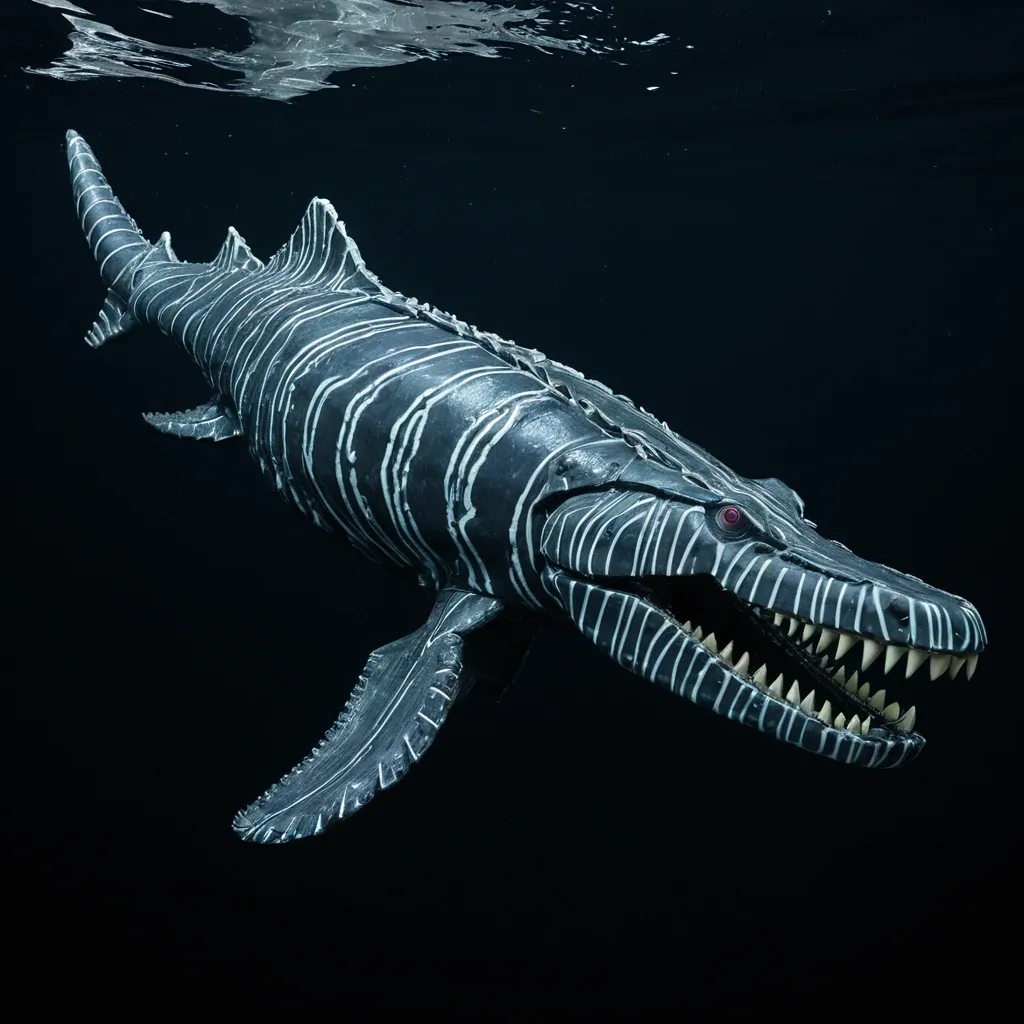
Length: 40-60 feet Weight: 50-75 tons Lifespan: 100-135 years Coloration of the Females is Slate gray base with white tiger stripes Bioluminescent red photophores arranged in tiger stripe patterns along the flanks and dorsal ridge , glowing vividly in abyssal darkness Body: Robust , muscular frame combining the thick , armored scales of saltwater crocodile with the hydrodynamic , flexible body of Mosasaurus Hoffmannii Fins: Large , rigid pectoral fins capable of tilting backward to reduce drag , inspired by the Black Marlin’s speed adaptations Limbs: Powerful flippers adapted for both swimming and short-distance land movement , similar to a leopard seal’s scooting style Jaw: Enormous , reinforced jaws with over 40 , 000+ PSI bite force , lined with long , razor-sharp canine teeth from Predator X and Megalodon genetics Skin: Coated with a thick mucus layer secreted like the Atlantic hagfish , providing parasite defense , moisture retention , and a slippery surface to evade predators and prey alike Respiratory system: Dual-function lungs and gills allow breathing in surface air and extracting oxygen from water , enabling survival from ocean surface to depths up to 9 , 800 feet Sensory: Passive listening capabilities from transient killer whale lineage enable near-silent hunting; bioluminescent photophores aid in communication and prey attraction in deep-sea darkness ,
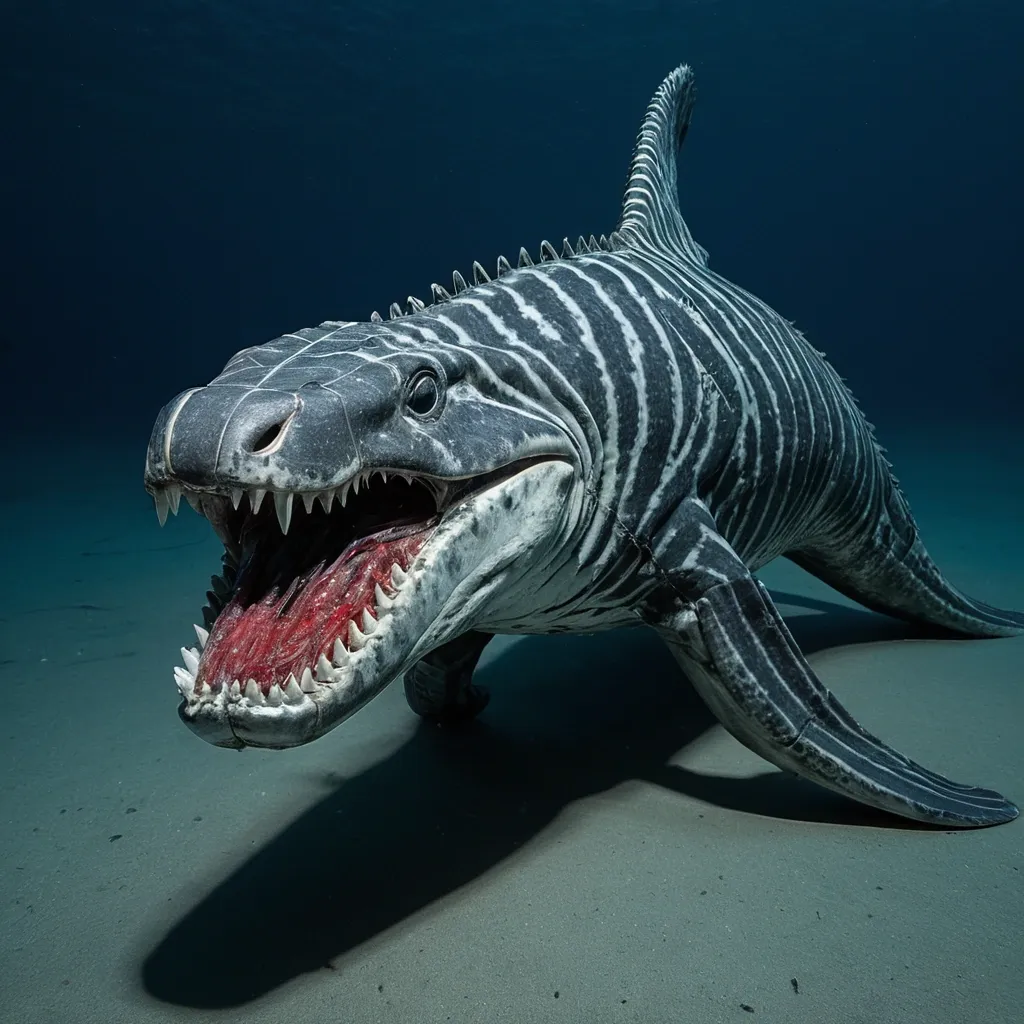
Physical Characteristics:Length: 40-60 feet Weight: 50-75 tons Lifespan: 100-135 years Coloration: Females are a slate gray base with white tiger stripes with Bioluminescent red photophores arranged in tiger stripe patterns along the flanks and dorsal ridge , glowing vividly in abyssal darkness Body: Robust , muscular frame combining the thick , armored scales of saltwater crocodile with the hydrodynamic , flexible body of Mosasaurus Hoffmannii. Fins: Large , rigid pectoral fins capable of tilting backward to reduce drag , inspired by the Black Marlin’s speed adaptations. Limbs: Powerful flippers adapted for both swimming and short-distance land movement , similar to a leopard seal’s scooting style. Jaw: Enormous , reinforced jaws with over 40 , 000 PSI bite force , lined with long , razor-sharp canine teeth from Predator X and Megalodon genetics. Skin: Coated with a thick mucus layer secreted like the Atlantic hagfish , providing parasite defense , moisture retention , and a slippery surface to evade predators and prey alike. Defense: Venomous spines inspired by the crown-of-thorns starfish line the dorsal ridge , delivering painful wounds to predators or rivals. Respiratory system: Dual-function lungs and gills allow breathing in surface air and extracting oxygen from water , enabling survival from ocean surface to depths up to 9 , 800 feet. Sensory: Passive listening capabilities from transient killer whale lineage enable near-silent hunting; bioluminescent photophores aid in communication and prey attraction in deep-sea darkness ,
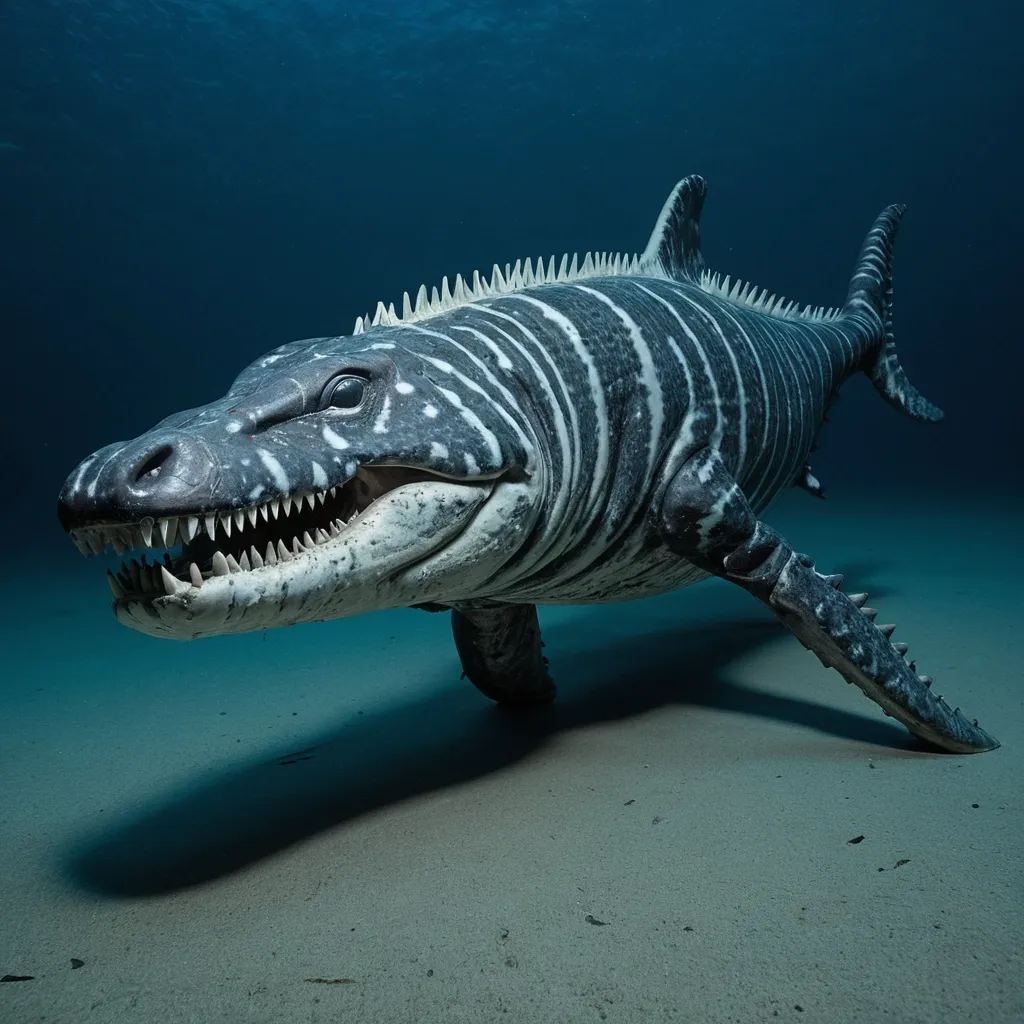
Physical Characteristics:Length: 40-60 feet Weight: 50-75 tons Lifespan: 100-135 years Coloration: Females are a slate gray base with white tiger stripes with Bioluminescent red photophores arranged in tiger stripe patterns along the flanks and dorsal ridge , glowing vividly in abyssal darkness Body: Robust , muscular frame combining the thick , armored scales of saltwater crocodile with the hydrodynamic , flexible body of Mosasaurus Hoffmannii. Fins: Large , rigid pectoral fins capable of tilting backward to reduce drag , inspired by the Black Marlin’s speed adaptations. Limbs: Powerful flippers adapted for both swimming and short-distance land movement , similar to a leopard seal’s scooting style. Jaw: Enormous , reinforced jaws with over 40 , 000 PSI bite force , lined with long , razor-sharp canine teeth from Predator X and Megalodon genetics. Skin: Coated with a thick mucus layer secreted like the Atlantic hagfish , providing parasite defense , moisture retention , and a slippery surface to evade predators and prey alike. Defense: Venomous spines inspired by the crown-of-thorns starfish line the dorsal ridge , delivering painful wounds to predators or rivals. Respiratory system: Dual-function lungs and gills allow breathing in surface air and extracting oxygen from water , enabling survival from ocean surface to depths up to 9 , 800 feet. Sensory: Passive listening capabilities from transient killer whale lineage enable near-silent hunting; bioluminescent photophores aid in communication and prey attraction in deep-sea darkness ,
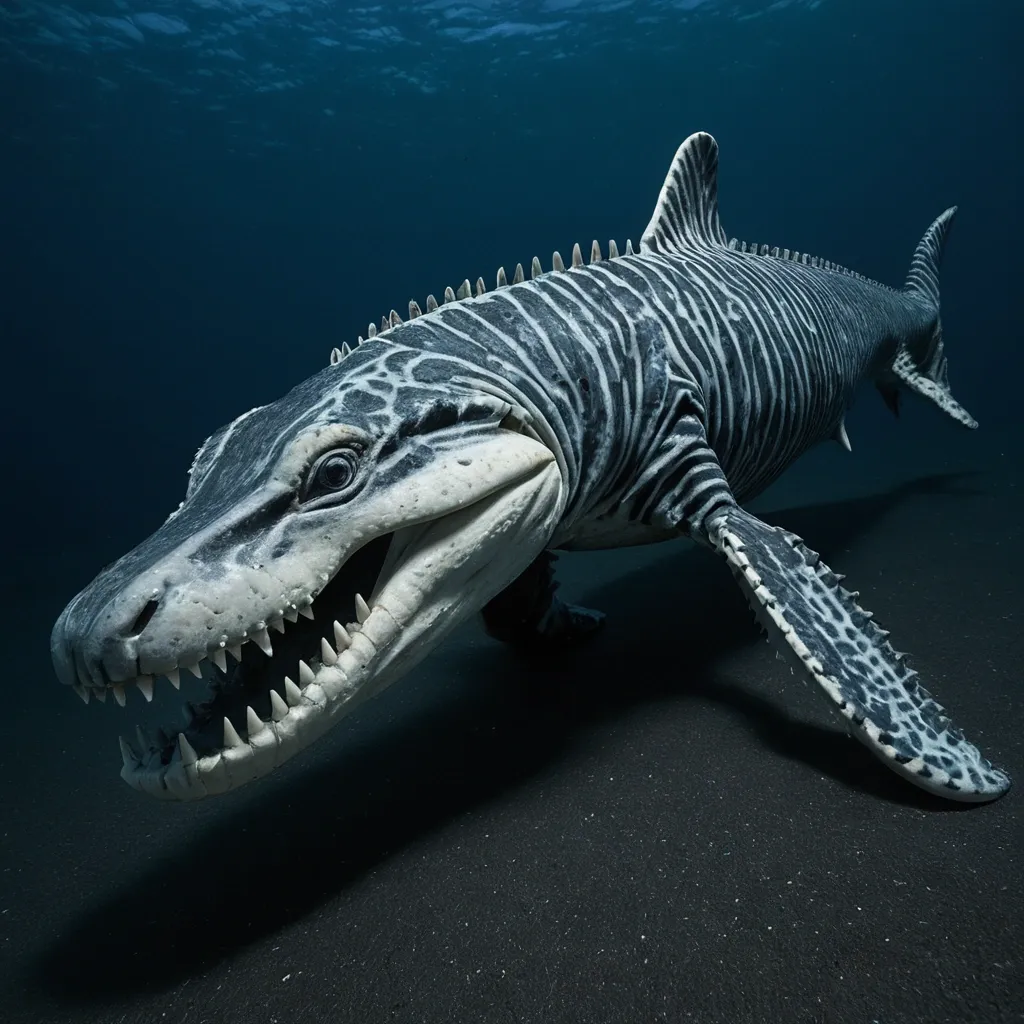
Physical Characteristics:Length: 40-60 feet Weight: 50-75 tons Lifespan: 100-135 years Coloration: Females are a slate gray base with white tiger stripes with Bioluminescent red photophores arranged in tiger stripe patterns along the flanks and dorsal ridge , glowing vividly in abyssal darkness Body: Robust , muscular frame combining the thick , armored scales of saltwater crocodile with the hydrodynamic , flexible body of Mosasaurus Hoffmannii. Fins: Large , rigid pectoral fins capable of tilting backward to reduce drag , inspired by the Black Marlin’s speed adaptations. Limbs: Powerful flippers adapted for both swimming and short-distance land movement , similar to a leopard seal’s scooting style. Jaw: Enormous , reinforced jaws with over 40 , 000 PSI bite force , lined with long , razor-sharp canine teeth from Predator X and Megalodon genetics. Skin: Coated with a thick mucus layer secreted like the Atlantic hagfish , providing parasite defense , moisture retention , and a slippery surface to evade predators and prey alike. Defense: Venomous spines inspired by the crown-of-thorns starfish line the dorsal ridge , delivering painful wounds to predators or rivals. Respiratory system: Dual-function lungs and gills allow breathing in surface air and extracting oxygen from water , enabling survival from ocean surface to depths up to 9 , 800 feet. Sensory: Passive listening capabilities from transient killer whale lineage enable near-silent hunting; bioluminescent photophores aid in communication and prey attraction in deep-sea darkness ,

Physical Characteristics:Length: 40-60 feetWeight: 50-75 tonsLifespan: 100-135 yearsColoration: Males has a Jet black base with light gray tiger stripesBioluminescent red photophores arranged in tiger stripe patterns along the flanks and dorsal ridge , glowing vividly in abyssal darknessBody: Robust , muscular frame combining the thick , armored scales of saltwater crocodile with the hydrodynamic , flexible body of Mosasaurus HoffmanniiFins: Large , rigid pectoral fins capable of tilting backward to reduce drag , inspired by the Black Marlin’s speed adaptationsLimbs: Powerful flippers adapted for both swimming and short-distance land movement , similar to a leopard seal’s scooting styleJaw: Enormous , reinforced jaws with over 40 , 000 PSI bite force , lined with long , razor-sharp canine teeth from Predator X and Megalodon geneticsSkin: Coated with a thick mucus layer secreted like the Atlantic hagfish , providing parasite defense , moisture retention , and a slippery surface to evade predators and prey alikeRespiratory system: Dual-function lungs and gills allow breathing in surface air and extracting oxygen from water , enabling survival from ocean surface to depths up to 9 , 800 feetSensory: Passive listening capabilities from transient killer whale lineage enable near-silent hunting; bioluminescent photophores aid in communication and prey attraction in deep-sea darkness ,
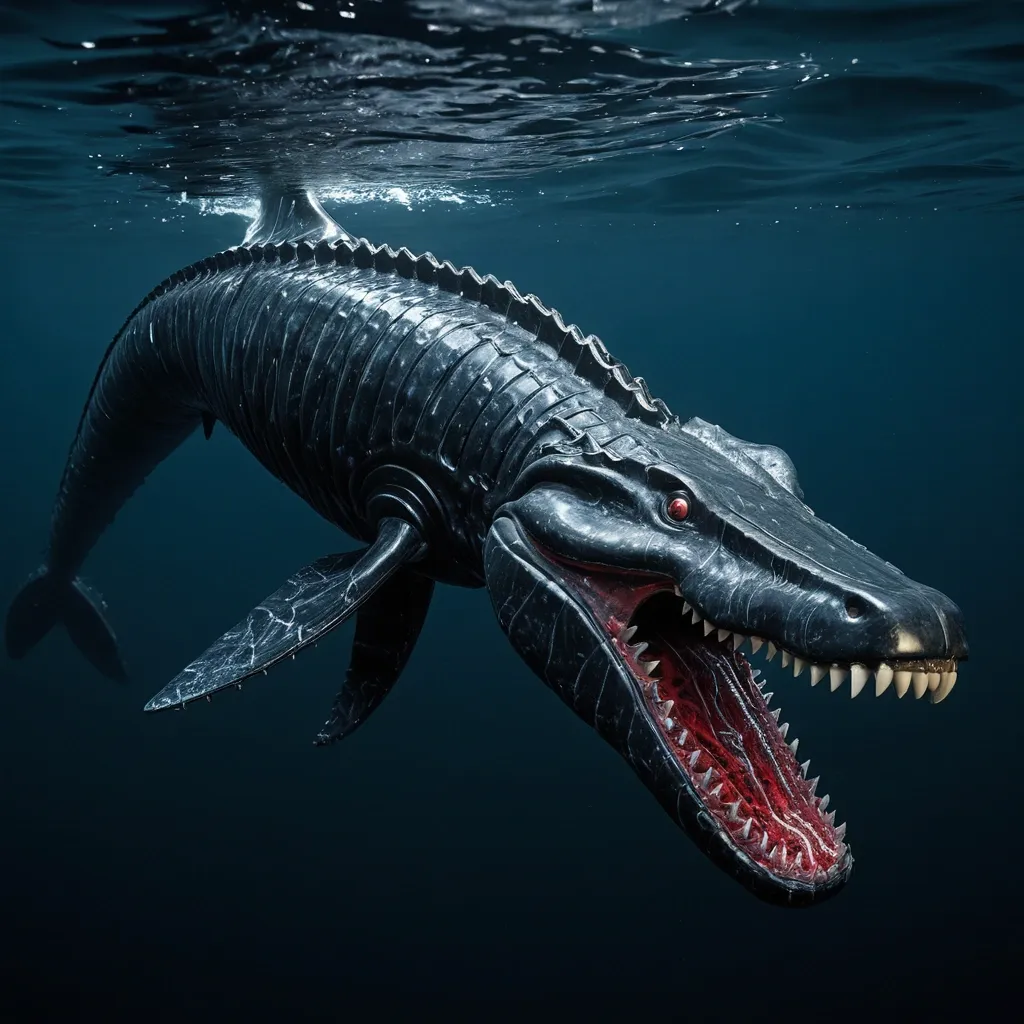
Physical Characteristics:Length: 40-60 feetWeight: 50-75 tonsLifespan: 100-135 yearsColoration: Males has a Jet black base with light gray tiger stripesBioluminescent red photophores arranged in tiger stripe patterns along the flanks and dorsal ridge , glowing vividly in abyssal darknessBody: Robust , muscular frame combining the thick , armored scales of saltwater crocodile with the hydrodynamic , flexible body of Mosasaurus HoffmanniiFins: Large , rigid pectoral fins capable of tilting backward to reduce drag , inspired by the Black Marlin’s speed adaptationsLimbs: Powerful flippers adapted for both swimming and short-distance land movement , similar to a leopard seal’s scooting styleJaw: Enormous , reinforced jaws with over 40 , 000 PSI bite force , lined with long , razor-sharp canine teeth from Predator X and Megalodon geneticsSkin: Coated with a thick mucus layer secreted like the Atlantic hagfish , providing parasite defense , moisture retention , and a slippery surface to evade predators and prey alikeRespiratory system: Dual-function lungs and gills allow breathing in surface air and extracting oxygen from water , enabling survival from ocean surface to depths up to 9 , 800 feetSensory: Passive listening capabilities from transient killer whale lineage enable near-silent hunting; bioluminescent photophores aid in communication and prey attraction in deep-sea darkness ,
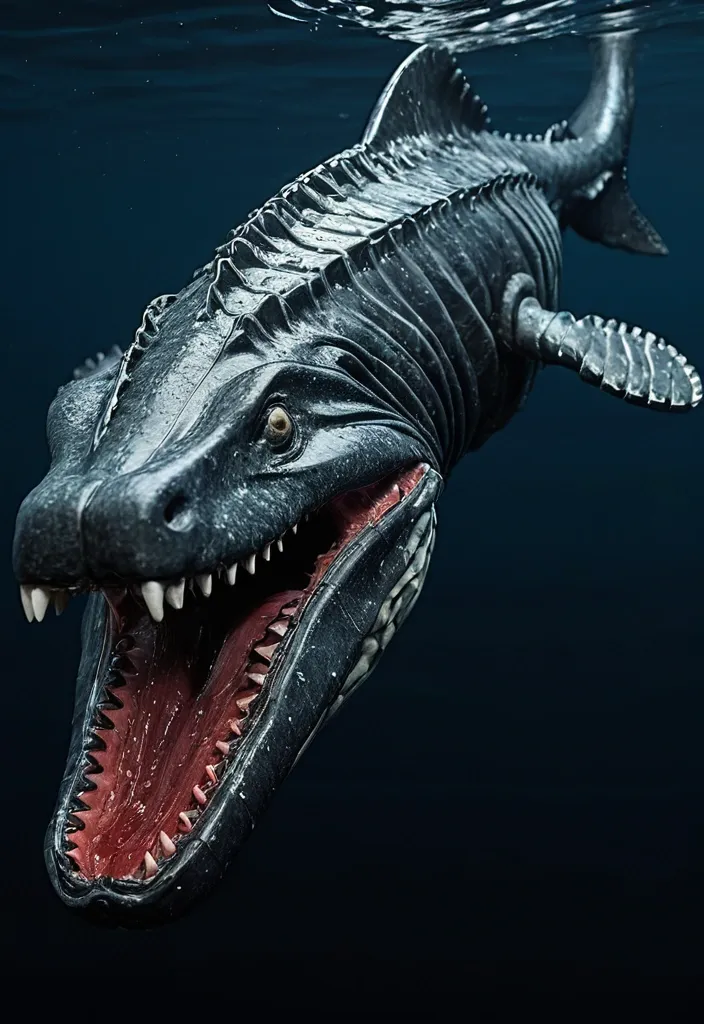
Physical Characteristics:Length: 40-60 feetWeight: 50-75 tonsLifespan: 100-135 yearsColoration: Males has a Jet black base with light gray tiger stripesBioluminescent red photophores arranged in tiger stripe patterns along the flanks and dorsal ridge , glowing vividly in abyssal darknessBody: Robust , muscular frame combining the thick , armored scales of saltwater crocodile with the hydrodynamic , flexible body of Mosasaurus HoffmanniiFins: Large , rigid pectoral fins capable of tilting backward to reduce drag , inspired by the Black Marlin’s speed adaptationsLimbs: Powerful flippers adapted for both swimming and short-distance land movement , similar to a leopard seal’s scooting styleJaw: Enormous , reinforced jaws with over 40 , 000 PSI bite force , lined with long , razor-sharp canine teeth from Predator X and Megalodon geneticsSkin: Coated with a thick mucus layer secreted like the Atlantic hagfish , providing parasite defense , moisture retention , and a slippery surface to evade predators and prey alikeRespiratory system: Dual-function lungs and gills allow breathing in surface air and extracting oxygen from water , enabling survival from ocean surface to depths up to 9 , 800 feetSensory: Passive listening capabilities from transient killer whale lineage enable near-silent hunting; bioluminescent photophores aid in communication and prey attraction in deep-sea darkness ,
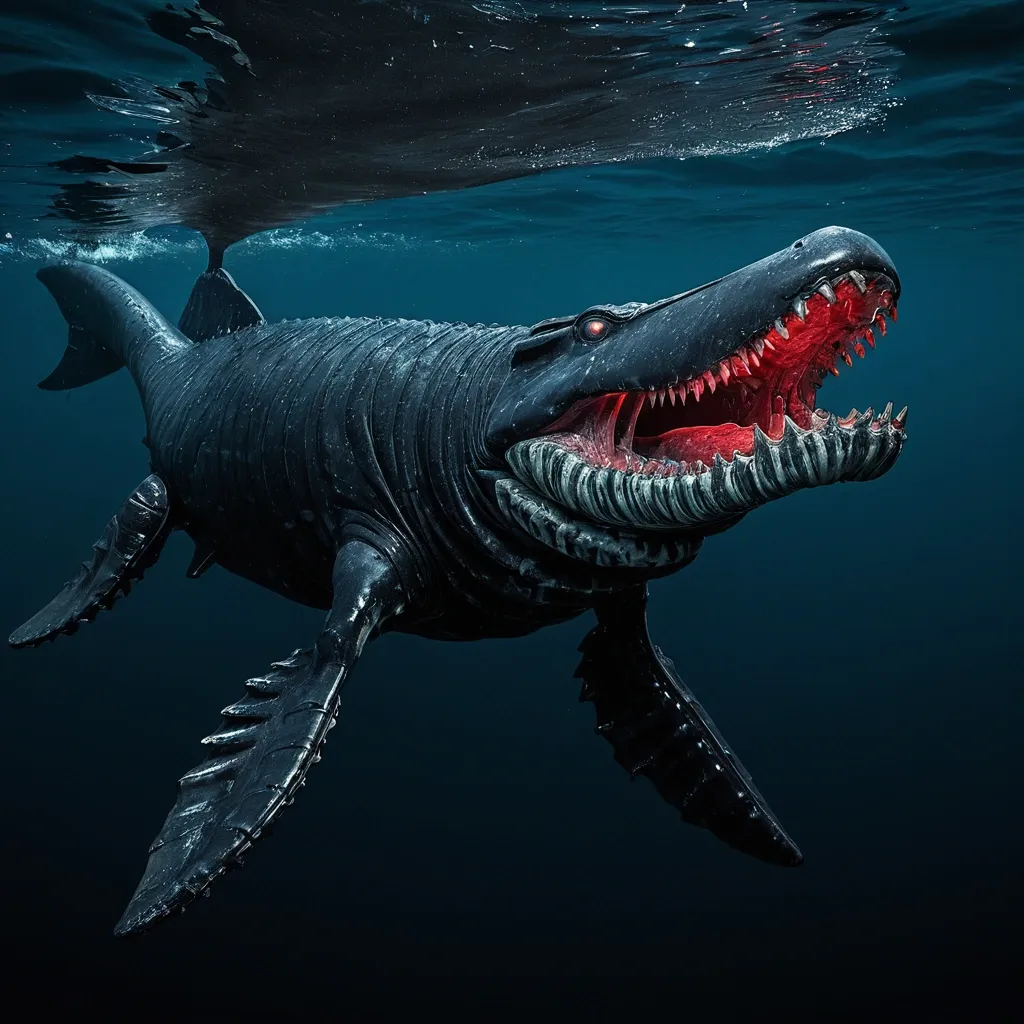
Physical Characteristics:Length: 40-60 feet Weight: 50-75 tonsLifespan: 100-135 years Coloration: Males are a Jet black base with light gray tiger stripes. Bioluminescent red photophores arranged in tiger stripe patterns along the flanks and dorsal ridge , glowing vividly in abyssal darkness. Body: Robust , muscular frame combining the thick , armored scales of saltwater crocodile with the hydrodynamic , flexible body of Mosasaurus Hoffmannii. Fins: Large , rigid pectoral fins capable of tilting backward to reduce drag , inspired by the Black Marlin’s speed adaptations. Limbs: Powerful flippers adapted for both swimming and short-distance land movement , similar to a leopard seal’s scooting style. Jaw: Enormous , reinforced jaws with over 40 , 000 PSI bite force , lined with long , razor-sharp canine teeth from Predator X and Megalodon genetics. Skin: Coated with a thick mucus layer secreted like the Atlantic hagfish , providing parasite defense , moisture retention , and a slippery surface to evade predators and prey alike. Respiratory system: Dual-function lungs and gills allow breathing in surface air and extracting oxygen from water , enabling survival from ocean surface to depths up to 9 , 800 feet. Sensory: Passive listening capabilities from transient killer whale lineage enable near-silent hunting; bioluminescent photophores aid in communication and prey attraction in deep-sea darkness ,